#they had a whole board on how they curated images and where they got them from
Text
The problem with A.I. art isn’t that it’s “not art” it’s that it’s art theft
If those A.I. art programs were using royalty free/ public domain images or even creative commons or stock photos , then this wouldn’t even be a discussion.
#alas they use random pictures they find on (eg) Art Station#anti ai art#had a convo with my sister ages ago about how the one thing computers will never be able to do is create art#and yeah#I could go on a really long tangent why art only has meaning if done by human hand and art definitions etc#but I’m tired#and actually#I was on an AI art exhibit this year and it was really cool!#but do you think those artists just fucking stole other artists art to feed their AI?? NO!!#they had a whole board on how they curated images and where they got them from
349 notes
·
View notes
Text
Like... the entire time I was trying to be Normie, I was learning about what other non-Normies thought Normie Culture was, and from Aspirational Normies who were locked out of normiedom but who would give me a hand until they got in and kicked the ladder out
I have never actually been part of Normie Culture. Nobody in any “How To Be Normie” setting is really Normie.
I wonder if Normiehood is actually some kind of American social class thing that nobody will admit is connected to intersections of class, religion, and the customs around goy whiteness
There is a ton of shit that’s weird and foreign to me, like Normie Dating. I didn’t really learn there were normie dating customs (are there???) until I was in Dating Advice Culture (tm). I’ve only actually been an incel when I’ve tried to click with people in “normie” ways - i.e., via flirtatious play with near-strangers, not via long conversations online first where we actually talk meaningfully about ourselves. Via meeting people with the specific intention of finding people to date/sleep with, rather than meeting people via my hobbies.
I always fucked up dating in normie culture, let alone dating neurotypicals, because the energy would just be too intense for them, whereas for me I felt like I had to play all of these games, because basically there are a ton of hidden social shit tests in normie culture to prove you’re not mentally ill more or needy (The Rules is hugely about passing those as a woman more than anyone wants to admit).
I feel too like in the Seinfeld Era, there really were a ton of people who dated just like the people on Seinfeld. It was a cringingly, horrifyingly realistic portrait of the urban yuppie dating scene.
And I feel like a certain class of *men* put women through shit tests too - they were trying to make sure that the woman in question wasn’t going to drain their resources and didn’t have, for lack of a better term, mental illnesses or any kind of higher support needs. I feel like the shit tests were more like... quietly observing to see how women handled a cancellation. Like, was she going to blow up his answering machine in between early dates.
I think this was specifically a thing with a particular group of men though (the specific kind of square, “High Value” yuppie man that they were looking for.)
The Rules board even had this one lengthy document called “What To Say, When” about all possible situations you could get into in interacting with men, and how to reply to things they said.
The community took it way way way further than the book did; the book is basically just an etiquette book with some rather old fashioned ideas about reputation and oversharing. I use it to this day for guiding my online public image management and also setting boundaries with business clients.
But the community took it so far that there was a whole script and performance and costume you wore for first dates and huge image management involved. You needed to curate your image to the least controversial image possible and the blandest most classic styles so that you attracted the widest assortment of men. (It did NOT work for anyone. All you do by trying to conform to a standard that heavily is increase your competition. Every person I’ve known, EVER, who has found love, has found it by flying their own particular brand of “freak flag.”)
You weren’t supposed to go off script on early dates! You were supposed to go on as many dates as possible, even with men you didn’t like, just so you could practice this shit.
#The Rules is basically How To Mask Your Autism or BPD On Early Dates#idk how successful it actually was#it was part of the culture shock I faced though Trying To Be Normie#like - The Rules pointed out to me what exactly I was having to mask#but the positive is that The Rules actually gave me tools for dealing with WOMEN - because I stopped giving women coworkers etc leverage
6 notes
·
View notes
Text
Intersections Project
I kept track of this on a presentation, so I am only writing this post right now with some additional notes.
At first, when I heard the brief, I was a bit confused and needed about 20 mins of pure thought to come up with some ideas. I presented three of them during a tutorial and chose the best one, which was about the intersections between languages.
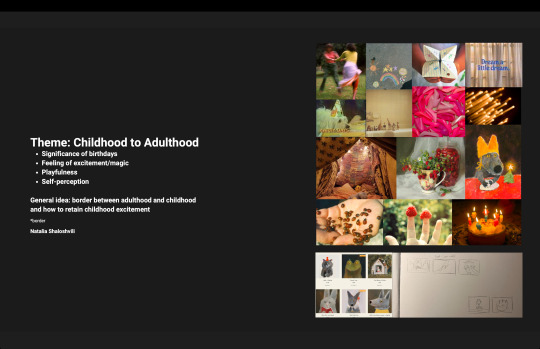

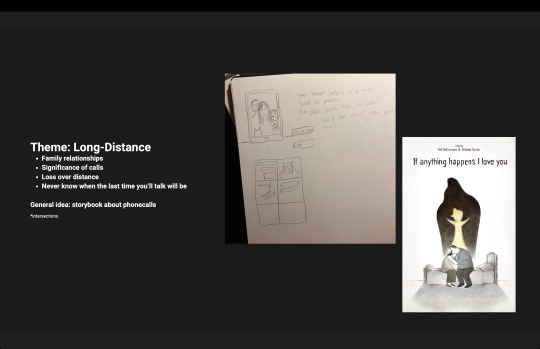
I got really excited about the idea and decided to make a series of posters about what it's like to learn a language.
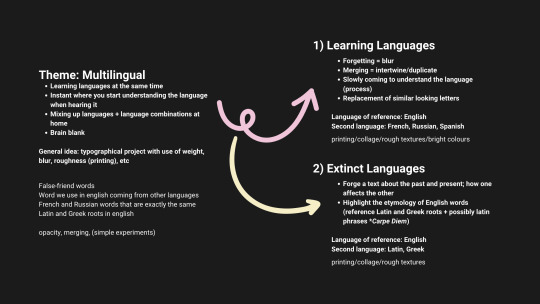
I looked into several typefaces that could work with the Russian and Greek alphabets as well. I landed on Coolvetica funny enough but it looked nice in all alphabets so I decided to keep it. But I also looked into these:

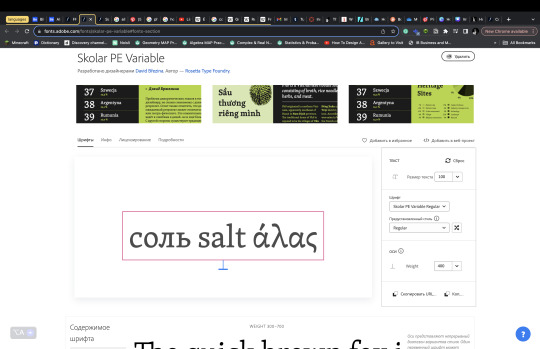
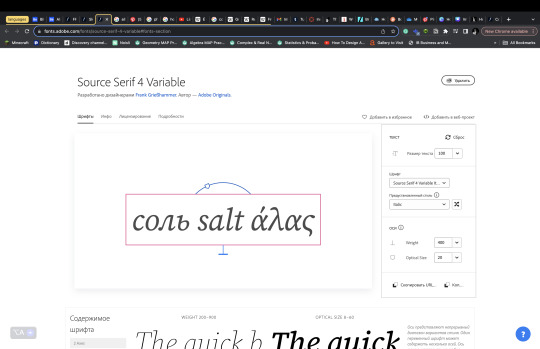
I did some extra mind mapping and plotted out the letters I could mix together to show the similarity between alphabets.


I curated a small mood board from images I found on Pinterest that gave off the visual vibe I wanted. I looked into several projects that I found on It's Nice That. I also looked into Paula Scher because I remember her campaign for the Public Theatre used lots of posters consisting of typography.


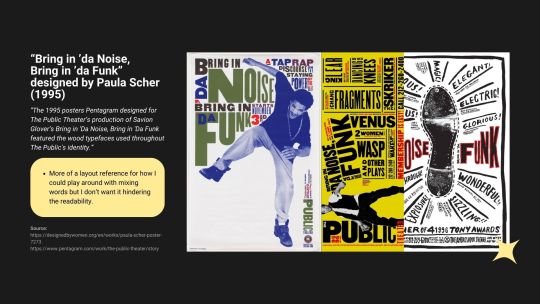
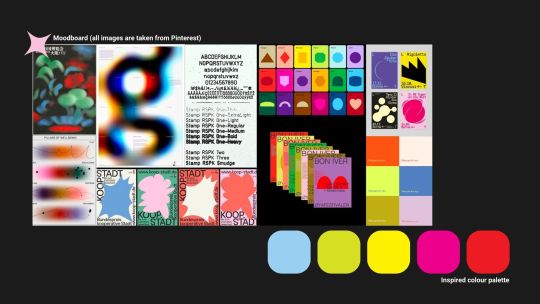
This is where I came to a standstill. Even after research and experimentation, my idea wasn't coming together visually, and I left it alone for a while.

Even though I showed the experiment to my second tutorial group, and they liked it, I didn't really feel right and couldn't bring myself together to work further on it. After some time and a tutorial with Rich I decided to give my other idea a shot, and if it didn't come together, I'd put it to rest and focus just on the posters. I also had this other idea of advertisement banners for a hospital where I could take apart difficult clinical terms' etymologies and use that as a metaphor to demonstrate how the hospital takes great care to look into your medical issues. But I said that aside because that would really change the visual I would need to create, and I was quite far into the project already. So I quickly wrote out the idea and actually, I really liked it.
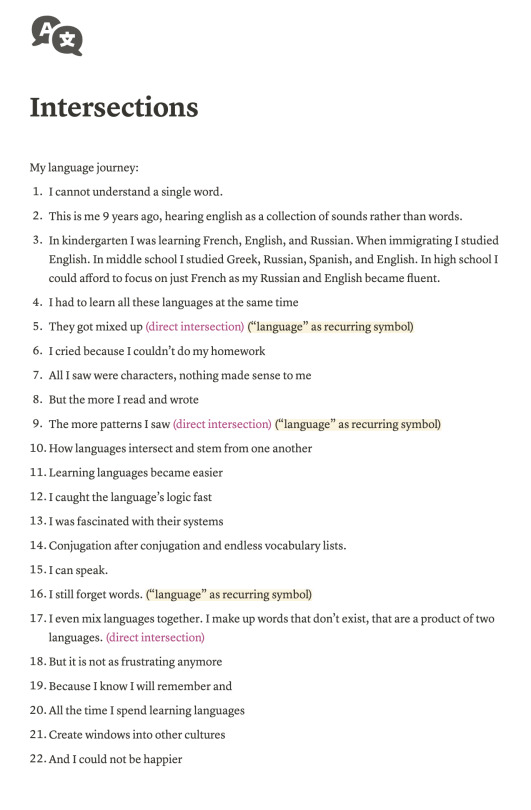
So I quickly got to sketching to see what I could possibly do to visualize it. I straight away thought a small square-shaped book would be perfect. This is the plan I came up with:
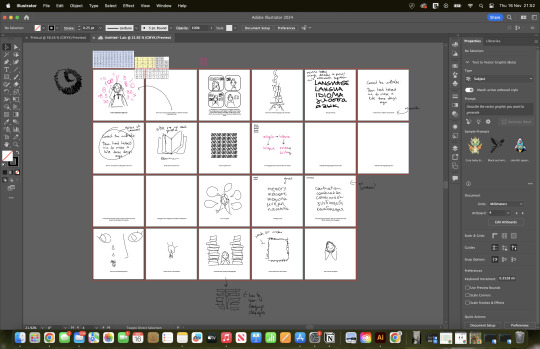
Before proceeding, I decided to look further into linguistics and typeface development, so I watched a crash course on linguistics and a documentary about Helvetica. Even though opinions are polarised, I thought it would make a good addition to my current level of knowledge.
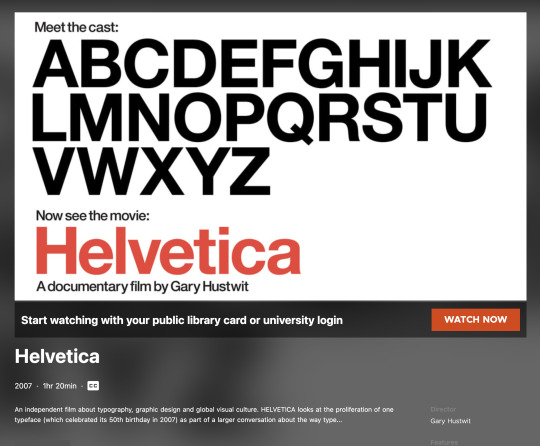
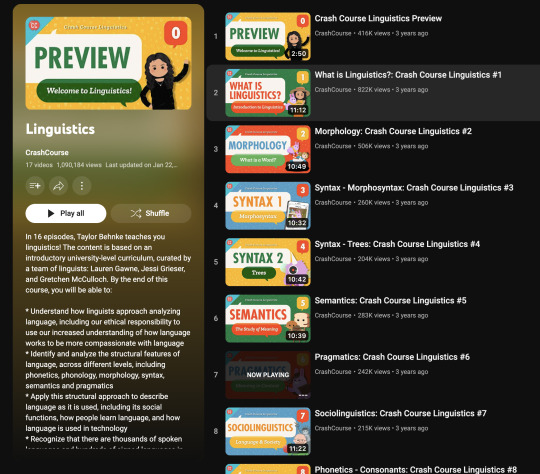

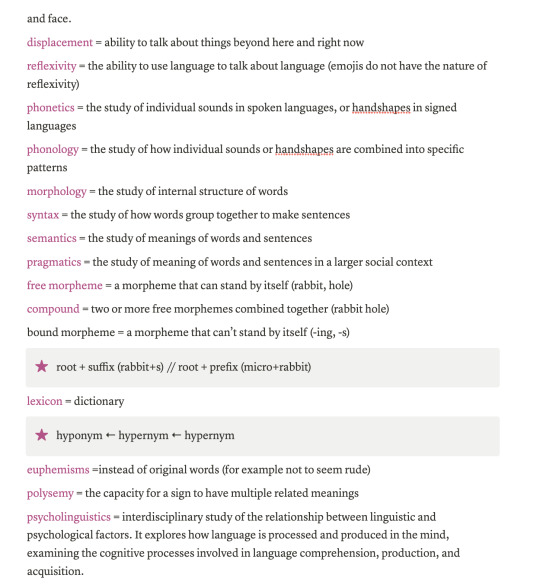
This research helped me finalise some of the ideas I had for the illustrations. And I just got to work. These were my final illustrations, some I struggled with but, nothing a but of thought can't solve. I left one page blank even though I planned on gluing a small book into it. During our last tutorial during the studio day, Briony mentioned that it was nice I left it blank. At first, I didn't really understand why and was still set on gluing in the book. However after giving it more thought I realised that I placed a single sentence on the whole page spread so it would be clever to have the illustrations on the spread connect to each other. So I made the empty page like my starting point where I didn't understand a lot, and once I did more reading and writing I saw patterns.

Next, I needed to make a book cover. First I thought I would make it white and simple to match the look of the pages and maybe add blurred circles of the same colors. But I tried it out and it didn't look great so I thought I'd made it a gradient. It goes along with the theme of the intersections as colours blend together and create a different colour.

Briony took a look at it and suggested to sleep the center theme going in the cover as well so I changed the positioning. She also said it would be fun to add a design to the inside of the cover and I thought it could help me enhance the concept. This was my final idea:

I made half of the inside black to represent the beginning of my journey, not understanding languages and only being able to use one, to the end where I could understand language's complexities and use several.
I made a test print on one of the VisCom printers the same day. The pages looked fine and Briony helped me out with centering the captions on the pages. I fixed them for the final printing on Thursday. Jordy showed me the paper stock and I picked the paper that i will use as well.
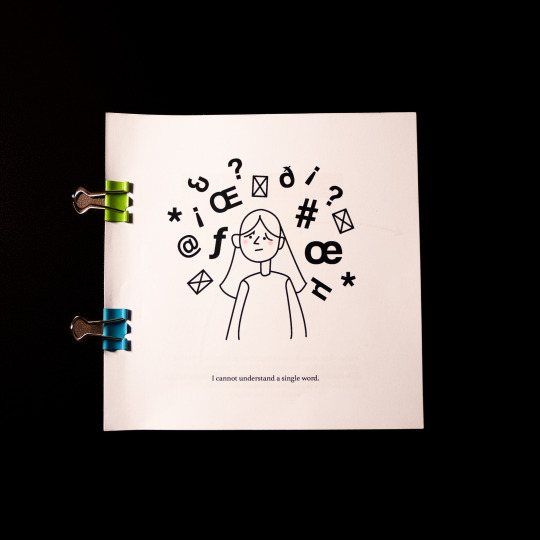
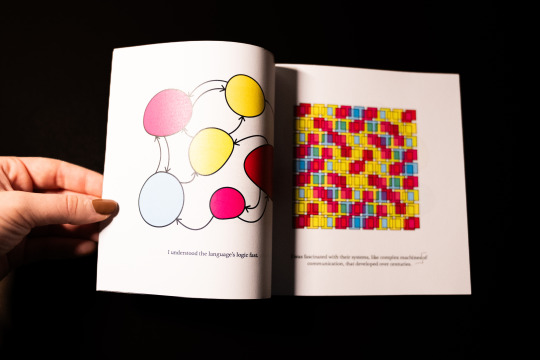
Printing day came, and I honestly thought I would be done in a bout an hour and a half but, I ended up spending 8 hours in the Mac Suite. The was an issue with exporting the cover because my gradients weren't rasterised so I quickly fixed that and gave the file to Jordy as only she could print it on the big printers (my paper was 300gr for the cover). Now when the pages printed on the Laser printers the blurred elements came out with an ugly outline. I couldn't make the book with something like that so I asked Jordy for help. She suggested rasterising them and increasing the opacity of the elements, but that did not help one bit. I thought it was the printer itself and asked if we could use a different one. Thankfully around 4 one of the graphics technicians came in as well and we ran a couple test prints on the Lasers again which didn't help so he suggested we print it on the Ink Jets on the graphics floor. The only thing was that it could not print double-sided automatically so I was waiting for the right moment to flip the pages and feed them back into the printer. This took 4 tries as each time an issue occurred but the pages were finally printed and I could not be happier.
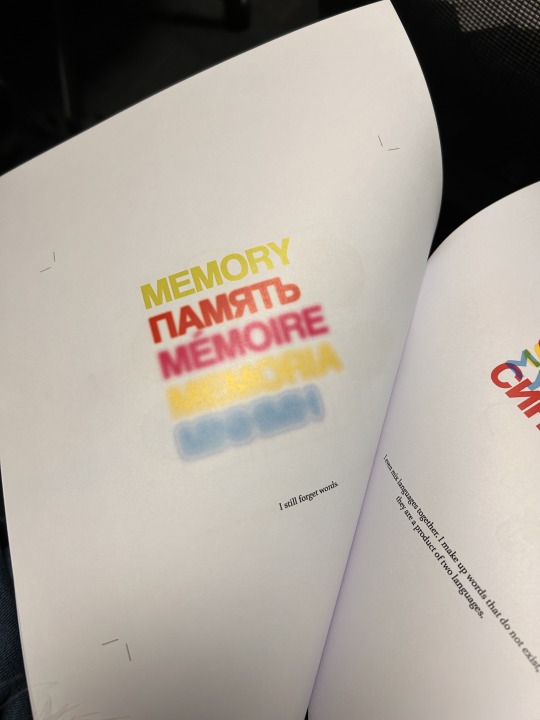

Finally on Friday, I had a slot booked to use the bindery during open access. I came, and everything went very smoothly. Joesph was super helpful and kind of read my mind as well. The room is always super chill and relaxing and I even got to talk to some 2nd years who were working on their process books. I did a perfect binding induction but I still needed several reminders on how to do what.
The book was quite thin for perfect binding, but we made it work. I also found out that I should leave at least 1mm extra for the spine, I made it too short but had 3mm bleed, so I didn't have to reprint in the end.
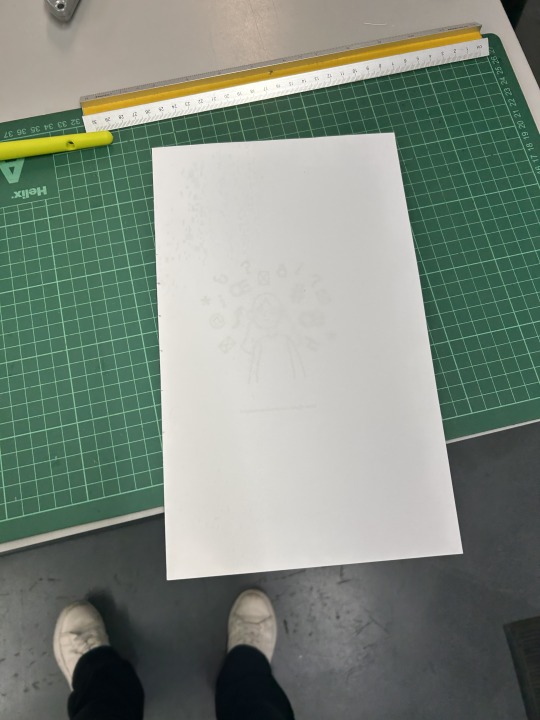
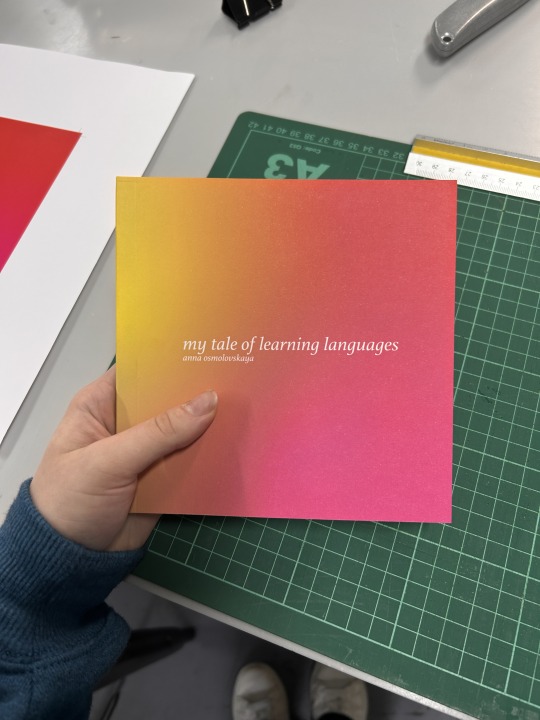
And this is my final product. I am thrilled with it.
0 notes
Text
Evaluation Part 2
This Promotion module has been an opportunity for me to explore the creation of promotional materials, developing an online presence, various exhibition formats and curatorship.
Initially, I investigated developing an online presence. Instagram seems to be the more popular social media platform for artists to promote their work. I already had an Instagram account dedicated to my artwork which I didn’t use much, therefore I tried to become more active about uploading my artwork there. I learned that consistently posting to social media platforms is a key aspect to building an audience. I also created an online portfolio; like collating my artwork on Instagram, except I only put up what I consider to be my best work. Whereas, on Instagram, I can upload developments, things that worked and things that didn’t. When researching Instagram as a promotional tool, I found that people who are fans of an artist enjoy learning about their thoughts behind the artworks and they appreciate a look behind the scenes; a more personal approach.
As a group, we organised an Instagram takeover to begin promoting our degree show. Each person on our course posted three images and a short statement about their artwork. One of us took over the act of accessing the Instagram account and scheduling the posts to upload around three times a day from the 19th to the 25th of April. This seems to have been effective considering the amount of “likes” each post got. As well as promoting my own artworks, I also posted the graduate show poster to get the word out - I posted a story about it on my personal account too.
As the graduate show is a collaboration between our group, BA Design Practice and BA Photography, it was important for us to work together to plan this event. A couple of people in our group took the lead on this and really made things happen in terms of organisation, communication with our collaborators and making the group aware of important updates and changes.
Researching curatorship was interesting as it was something that I hadn’t considered before. I didn’t realise that there were so many aspects to this role in the art world. Three people in our group took on the role of curator and they made everyone's lives easier with regard to sorting out the degree show floor plan and organising where each artist fits in the space. Some of the artists are sharing a space due to the lack of boards but the curators paired them up by how different the artworks are so that it’s obvious that two artists are sharing the space.
I was mostly influenced by the Repeat Patterns exhibition by Mandy McIntosh and Helen De Main at the Glasgow Gallery of Modern Art regarding exhibition format. I enjoy the simplicity of their prints mounted on the walls and I plan on carrying out a similar process when installing my large-scale drawing in the degree show space - the only difference being that I will be using command strips instead of pins.
As a whole, despite being unable to get fully involved due to personal health issues, I learned a lot about what it takes to promote my art, myself as an artist and my eyes were opened to the possibility of helping others with their exhibitions in terms of curation and promotion.
0 notes
Text
The New Routine
I wrote this a few days ago and I am not sure where it came from. I am still going to credit @yangkoogan @earthfluuke @gaysarawat and even @brightwin (Jelly’s song is so fantastic - go listen!!) for putting these two as a pairing in my head.
I fondly refer to this one as ‘the one where they don’t realize until too late that they’re already dating’.
The gang was down to two. Phuak had left on his education exchange and Tine was attached to the hip with Sarawat or at cheerleading practice. This left Ohm and Fong without much direction, neither of them had ever been at the helm of making social plans so they often found themselves half heartedly doing the same things they had done with Phuak and Tine around: going to bad restaurants, bar hopping and playing too many hours of videos games.
All Fong knew was that he still wanted to spend time with Ohm but something felt off about how they were spending their time together. It didn’t exactly feel wrong as it didn’t necessarily matter what they were doing, it just seemed like they were going through the motions of how they used to spend time with Phuak and Tine instead of making their own way. Fong hoped that this reality wouldn’t get in the way of them continuing to spend time together as there was something very grounding about spending time with Ohm that kept Fong sane.
One day, Ohm showed up on Fong’s doorstep with what appeared to be a picnic basket and a flicker of adventure in his eyes.
“Ready?” Ohm asked and Fong was rendered speechless. Upon noticing this, a flicker of apprehension crossed Ohm’s face before he continued, “I decided we needed to mix it up. Do something spontaneous.”
“S-sure.” Fong’s confusion suddenly turned into amusement but he held back his chuckles by biting his lip. “Where are we going exactly?”
“Adventure means mystery.” Ohm exclaimed, pulling out a pair of car keys and dangling them in front of Fong’s eyes. “We are going to drive until we feel like we need to stop.”
“Need to stop?” Fong questioned. “Do you mean like we’ll sort of just listen to our hearts and see when our intuition tells us to we’re where we need to be?”
Ohm nodded so earnestly in response that it almost broke Fong’s heart. He instantly recognized that his friend was going out of his comfort zone to try something new to redefine their new normal without their other two friends - to prove that they could make a new way of things without Tine and Phuak’s influence.
“Exactly.” Ohm answered. “So get your ass into gear and let’s hit the road.”
Fong slipped on a pair of shoes and was out the door in a matter of seconds. He had no idea what the day ahead held in store but the fact that Ohm was going out of his way to plan something different made Fong excited and nervous at the same time. It was so unlike their norm that it made Fong’s head reel with anticipation. He wondered what had inspired Ohm’s whirlwind suggestion for an adventure but decided not to overthink it too much lest he ruin the experience by over analyzing his friends intentions.
“Ready.” Fong shared as he locked his dorm room behind him and smiled at Ohm.
“Let’s do this.” Ohm declared excitedly before grabbing Fong’s hand and taking off in a run toward the parking garage.
The whole scene must have looked so ridiculous to an outsider but Fong was already having so much fun with Ohm that he didn’t care if they looked completely insane. They got to the car and Ohm let Fong’s hand go before opening the passenger door for his friend.
The action made Fong smirk as he climbed into the car and put on his seatbelt. “I guess chivalry isn’t dead.”
Ohm laughed lightly at the response before placing the basket into the trunk and slipping into the driver’s seat. He rested his hands on the steering wheel after starting the ignition. He backed up and pulled on the main road of their university before asking, “Okay - so, North or South?”
“You seriously have no idea where we’re going?” Fong asked in surprise. “I figured the spontaneity thing was an act and you had a meticulous plan in place.”
“That would be how you would plan it.” Ohm responded and while it could have seen as an accusation if anyone else had said it, Fong knew that Fong meant no judgement with his words. He was just stating the facts because he knew Fong so well. “I, however, am choosing to surrender today’s destiny to the universe and see where fate takes us.”
“I feel like you have been reading too many self-help books. Or actually, knowing you, it was a self-help reddit chain.” Fong shook his head in amusement before chewing on his lip in contemplation. “Let’s go… somewhere with water.”
“You can’t be that specific!” Ohm cried out in protest. “North or South? We’ll see if water is what happens. And yes, maybe I have been down a few ‘make your own way’ threads on the internet lately but, hey, I’m choosing to make this a reality through action!”
“Okay… North!” Fong answered loudly, matching Ohm’s slightly manic energy. He knew his friend was excited about the prospect of paving their own way so he would lean into that as much as possible. This was already the most exciting thing they had done in months and they had barely even left campus yet.
“North it is.” Ohm agreed and turned onto the ramp that led North and merged onto the highway.
They settled into a comfortable silence for a while, unsure of how they were going to decide when exactly the right moment was to stop but both Ohm and Fong were simply enjoying their shared time together, especially with no specific criteria on their plans for the day aside from a picnic and a drive.
“I… made a playlist.” Ohm announced about ten minutes into their drive and looked surprisingly embarrassed by the admission.
Ohm had never shown much interest in music so Fong was pleasantly amused by the fact that his friend had gone out of his way to curate a playlist for their mini road trip. It made Fong realize that Ohm had actually put a lot of thought into their plans for the day despite wanting it to see like a ‘spontaneous’ proposition.
“Put it on.” Fong encouraged his friend and Ohm quickly connected his phone to the car’s speaker system.
As the first song began, Ohm turned his attention back to the road and started humming along with the first song which happened to be one by Scrubb. Fong watched Ohm start to bob his head along with the music through his peripheral vision and the sight made something in his chest ache and wish he had seen more of this side of Ohm before. This unguarded, completely in the moment and open to whatever possibility came their way version of his best friend fascinated Fong and he couldn’t wait to see where it took them.
The next song on the playlist was by CtrlS and Fong couldn’t help but be shocked. Ohm had never been particularly on board with the Tine and Sarawat situation, mostly because Ohm was so protective of Tine. Fong had been forced to do some major convincing to get Ohm to tolerate Sarawat’s presence so he was shocked to hear a song by Sarawat’s band on the playlist.
“Don’t even start.” Ohm blurted out before Fong could call his friend out on his hypocrisy. Ohm continued over Fong’s laughter, “Just because I like his music does not mean I like him.”
Fong rolled his eyes at how stubborn Ohm was. He knew that it came from a place of fierce protectiveness for his friend and it made Fong realize just how much Ohm cared for the people around him, despite how much he tried to downplay the emotions that he let others see.
“Fair enough.” Fong responded before spotting what looked like a green space of off the highway. “Hey! What if we stop here?”
“See? Told you it would just happen.” Ohm’s eyes lit up immediately and all the negativity that came with Sarawat being brought up melted from his expression.
Fong couldn’t help but feel a wave of fondness flow over him as he watched his friend relax into his usual positive demeanour. He turned off of the highway and found a parking spot near their destination. He hoped there was some sort of body of water to wade into considering the sun was beating down so intensely that his forehead had a fresh layer of sweat on it despite the car’s air conditioning.
“Here.” Ohm reached over after he shut off the car and pressed a handkerchief to Fong’s forehead before Fong even registered what was happening. Fong’s breath hitched at the close proximity and suddenly noticed the array of colours that were housed in Ohm’s eyes.
Ohm pulled away the handkerchief and gave Fong a funny look, “Do I have something on my face?”
“N-no.” Fong’s cheeks burned at the question. “Thanks for that. Let’s try to find the water.”
Ohm pocketed the handkerchief before he shrugged and jumped out of the car. Fong collected himself and got out of the car as Ohm grabbed the basket from the trunk. Fong spotted the water in the distance and he raced toward, whether to escape the conflicted feeling he was experiencing or just because he loved the water so much, he wasn’t sure.
Fong heard Ohm trying to keep up with him as he reached the shoreline. Fong was thankful for the breeze as it helped calm down the blush that was presently on his face. He needed the momentary distance to recover from whatever the hell was going on between him and Ohm. The foreign feeling had popped out of nowhere and he felt himself struggling to navigate it.
“Are you going to go in?” Ohm asked and threw an arm over Fong’s shoulder.
The contact that usually felt platonic and casual suddenly was charged with something that Fong couldn’t quite place but he didn’t dare to separate himself from Ohm in fear that Ohm might read it as Fong being uncomfortable with the choice of outing.
“I don’t think so. I’m happy to just dip my feet in.” Fong murmured and looked toward his friend. The sun was dancing across Ohm’s face and Fong was taken aback by how serene the image was. His mouth felt dry and he was struggling to put words together but finally he managed to blurt out, “Should we find a spot to eat something?”
“That sounds great.” Ohm nodded firmly and moved his hand to grasp Fong’s again as if the gesture was something they did on a regular basis instead of it being a new occurrence. Fong was surprised to find himself relaxing into it and even finding comfort in the connection.
Ohm led them to a grassy spot in the shade of a tree and let go of Fong’s hand before opening up the basket. Fong watched as Ohm pulled out a blanket and draped it across the ground. A fleeting thought of just how romantic the whole scene was appeared in Fong’s mind and he was back to square one with a new layer of sweat spreading across his forehead, this time inspired by how nervous he suddenly felt. He obviously was overthinking this whole thing and Ohm was just trying to do something fun and different for his friend without thinking about the specific parameters of how date-like the whole setup was.
“I didn’t know exactly what you would like in terms of sandwiches so I made a tuna salad one and a peanut butter and jelly.” Ohm explained as he pulled out a few containers as he sat down on the blanket. “I also have a bunch of fruit and some drinks if you want one.”
Fong had to bite the inside of his cheek to keep from grinning widely at how adorable the whole situation was. Ohm looked at Fong expectantly and patted the empty space beside him on the blanket as an invitation for Fong to join him. Fong sat down and answered, “I think I’ll go for the peanut butter and jelly.”
“I figured that would be the case.” Ohm shared, seemingly pleased with himself as he handed Fong the container with the sandwich.
Fong opened up it up and began to munch of his sandwich as Ohm opened up the rest of the containers, humming absentmindedly as he went about the work. Ohm reached into the basket again and pulled out a container which appeared to be filled with lemonade.
“I’m so tired of those chewie drinks we have all the time.” Ohm shared, “So I made some lemonade from scratch!”
Fong was quite overwhelmed with the time and effort that Ohm had put into all of this - he wasn’t quite sure how he was going to make up for this the next time they went out together. Without thinking, he muttered, “I don’t think I’ve put this much effort into an outing even if it was for an actual date.”
Ohm suddenly froze and Fong immediately realized the implications of what he just said. Fong began to flounder for how to possibly retract the words or somehow play it off as a joke but the silence that stretched between he and Ohm made Fong feel like he was drowning. It wasn’t exactly awkward, it was just… heavy.
Shockingly, Fong didn’t find himself particularly afraid of the weight behind his words, he was more worried that he had made Ohm overthink his actions as much as Fong overthought his own. Ohm was the definition of carefree so the fact that he seemed to be absorbed in thought meant that he was seriously considering the words that Fong’s filter hadn’t quite caught.
“I…” Ohm began to speak and stopped himself before starting up again after he looked directly into Fong’s eyes, his gaze quite serious. “Would it be okay if it was an actual date?”
Fong felt his heart leap into his throat at the question. He knew that something had shifted between them since they started to spend time just the two of them but he had never been brave enough to admit that their relationship had started to lean toward something more than just friendship. It was somewhat of a relief for Fong to realize what had changed and in a moment of blind courage, he reached across and took Ohm’s hand in his.
“Yah.” Fong assured Ohm who looked as if he was terrified to hear how Fong was about to respond. “I think that would be more than okay. It’ll be like our new… routine.”
“How can you still be so rational at a time like this?” Ohm burst out laughing, throwing his head back before collecting himself. “But that’s what I think this works so well…”
Ohm squeezed Fong’s hand reassuringly and Fong’s mind was flooded with possibilities of what was next for them. He sighed deeply and Ohm pulled him closer so that Fong’s head could rest on Ohm’s shoulder. When the close proximity had made him panic before, it now made Fong completely relax into…
Their new normal. Their new routine.
Because sometimes you just have to try something new to uncover something that was already there.
#ohmfong#ohm x fong#2gether#2gether the series#my writing#thai bl#gmmtv#sarwatine#still 2gether#I am still not over these two and I dont know if I ever will be
86 notes
·
View notes
Text
Lies Untold

Part of The Untamed - EXO Wolf Universe
Genre: Supernatural, Wolf Au
Pairing: Luhan x Reader
Summary: For generations, your family has been the protectors of mankind. You were considered one of the best and due to that reputation, you were sent on what could be the most important mission for the organization. Going under cover in a college to sniff out a particularly large and threatening wolf pack seemed easy enough. But when you meet one of the members, everything you’ve known since birth will be overturned and your loyalty to your family and heritage will be tested.
Part: 1 I 2 I 3 I 4 I 5 I 6 I 7 I 8 I 9 I 10 I 11 I 12 I 13 I 14 I Final
**
Paper was strewn everywhere. A corkboard full of photographs and strings and sticky notes that would make any sane person think that a major conspiracy theorist lived here was currently leaning against a wall. And maybe that’s what you were, a person losing grip on reality as you tried to tie everything together. You still weren’t sure of the pack’s size or ranking even after another week of following them around. Confirming who was apart of the wolves was proving more difficult than you’d first imagined. Innie tended to hangout with the same group and they would mention others in brief conversation, but you couldn’t find faces to go with the unknown names.
One thing that you were at least ninety percent certain of was the fact that the professor – named Kim Junmyeon according to the university directory – was the alpha. How he was able to control such a large pack all by himself was something you couldn’t fathom, but somehow he managed it. You’d witnessed the others going to him for advice or permission for things and he just had that alpha aura radiating off of him. He wasn’t genetically an alpha, from what you observed. God, you hoped you never had to encounter one of those. Even with all your training, you didn’t think you could survive that fight.
Standing in front of the board that was currently giving you a headache, your eyes kept lingering on one wolf in particular. With his long, forehead-covering hair and soft, welcoming eyes, you found yourself in a strange struggle that you’d never experienced before. Granted, this was the first time you’d ever been this close to a pack before that wasn’t on a hunt. You were forced to be around them in their fake forms, their human forms, and you were pretty sure it was messing with your head.
No. You were strong enough for this. You could keep your focus. You would not fall victim to the façade that was their human shapes. They were monsters that shouldn’t exist. Your family’s history was enough to prove that.
But even now, your skin tingled where Luhan’s fingers had brushed up against your hand. The night before, he even made a brief cameo in your dream. You couldn’t remember the exact details of the dream; you weren’t even sure if there was a plotline or if it was just a bunch of random images. You do remember Luhan’s face making an appearance, though, and it was aggravating you.
Feeling your blood beginning to boil in your veins at your frustration, you swiped up your bag that was carrying your surveillance equipment and threw it over your shoulder before stomping out of the apartment.
You needed to get back in the game. You needed to focus on finding a way to get to the book and give your family the upper hand it had always been lacking. That’s why you were sent here. This was no time to start questioning your world view.
The only thing you could think of doing at the moment was taking another trip to the museum. Last time you were staking the place out, you’d noticed the curator and the girl who’s name you figured out was Kita disappear into a hallway guarded by a locked door. The only way in was with a key card. Perhaps spending another round in the building would help you create a game plan for getting one of those key cards without leaving a trail and checking out if the book was hidden in one of those off-limits rooms.
Instead of taking the bus this time, though, you decided to walk off the pent up energy in your muscles. It was a couple miles and would take you through the central business district, but that was just another stroll through the park for you.
Walking down the sidewalk, you had your headphones in your ears with no music playing to give off the illusion that you were not to be disturbed while you were able to keep your eyes open for anything suspicious. Many families and friend groups were taking advantage of this beautiful day, milling about among the shops and little locally owned restaurants. They all looked so happy, unaware of the secret world around them.
According to another faction among the organization - one that’s job was to keep an eye on any witch covens - there was a group of witches in the neighboring town. This college city used to have it’s own for several generations, but something happened about two years ago and they were all stripped of their magic, leaving the area to be completely controlled by the wolves. And every single human in this place was completely unaware of the transition.
Sometimes, you wondered what it would be like to be one of them, to not have been trained since the age of four on how to fight, to kill, to keep those you loved safe. What did that blissful ignorance feel like? Was it as happy as everyone seemed to make it?
You didn’t hate being a hunter. Never would you say that you loved it; that might sound a little sadistic and you saved that description for Johnny. It was simply your life and you’d never thought about trading for the other side for it before. You didn’t know what that other side was like. Not like your mother, who knew it very well. She came into this life after meeting your father. Well, more like she met your father because of this life.
She’d been walking home from an evening class at her university one night when an omega attacked her. Your father had been tracking it down and lost the trail for just a few minutes, but it was enough for the omega to find it’s next prey. She never went into detail about it, but to this day your mother carried the claw marks on her stomach. As your father nursed her back to health, they fell in love and she vowed to be apart of the fight. She acknowledged that she got lucky and that there were others that wouldn’t be. It was now her mission to make the number of unlucky ones decline as much as she was able to.
Your mother had always stated she never regretted her decision and she’s never looked back, missing her old life. So, that had to mean that you had the better end of the deal, right?
“(y/n)!”
No. Keep walking. Pretend you didn’t hear.
But the last person you needed to see right now kept calling after you. By the direction his voice was coming from, you knew he was behind you. You didn’t stop. You couldn’t speed up either, because that would be acknowledging the fact that you could hear him. Maybe you’d get lucky and he’d give up.
That was not the case. He caught up to you quickly, stopping you with a hand on your shoulder.
Instincts kicked in and you grabbed his hand, twisting it as you turned around. You weren’t using your full strength and so you weren’t surprised in the slightest when he didn’t show any sign of pain like any ordinary human would. But you faked the surprise, mostly to keep up the act that you hadn’t heard him.
“Shit, you scared me,” you said breathily to add to the charade. You took out the earbuds and stuffed them in your pocket before he could pick up on the lack of music.
“I guess I should have yelled louder,” Luhan chuckled. You let him go and he ran his fingers through his blonde hair, still smiling at you. There was no way that hair could be natural, right? And why was he always smiling around you? You didn’t exactly give off the vibe of sugar, spice, and everything nice. “Are you feeling better?”
You blinked at him, confused. That day at the pizzeria was nearly a week ago. And he was genuinely asking you about your health? “Um, yeah. I think I just ate something weird that day for breakfast.”
He nodded. “Good, good.” Bouncing from foot to foot, he gave off a sense of nervousness. “Are you busy right now?”
“Oh. Um.” You frowned, biting your bottom lip. Was he about to ask to spend some one-on-one time with you? Would that be a good idea if you said yes? The museum would still be there to check out again on another day and you could gain some helpful insight on his pack by speaking with him. Shaking your head, you turned your frown upside down. “No, I’m not. Why?”
A laugh escaped him as if he was taken by surprise by your answer. “Do you want to grab a cup of coffee? With me, that is.”
“Sure.”
Did you just freaking giggle? That wasn’t even you acting as the sweet one. It just… came out after his self-correction. What the hell was going on?
Taking a breath, you pointed to a coffee shop just at the corner of the block and started for it. “There’s that one-”
“No, not that one!” Luhan shouted as he stopped you with a grip on your upper arm. You stared at him wide eyed at the sudden outburst. Clearing his throat, he started to tug you to another shop across the street. “Their coffee sucks. And I know one of the staffers. She’s really nosy and we’d hardly be able to talk because she’d be hovering the whole time.”
“Really?” You looked over your shoulder at the reject shop, mentally notating it in your metaphorical files. Was it a mate that worked there? That could come in handy later.
“Yeah, this one’s much better,” he replied as he pulled you through the crosswalk, careful to keep an eye out for any runaway traffic. His hand had slipped down from your arm to your exposed hand and that fiery tingle was back in full force. Your heart was pounding in your chest and this time… you didn’t think you could completely blame it on your curved fight or flight senses.
Once inside, he let go to which you were both relieved with and aching for more. You shoved your hands in your pockets to keep them under control. Luhan asked for your order, but you shrugged and told him to surprise you. He got a cheeky look in his eye and ran to the front, leaving you alone to scan the area. An empty table for two was sitting in a corner near the front of the store, but right when you took a step towards it, Luhan was back.
“Let’s sit back there instead,” he suggested, nodding towards a booth that was mostly hidden from the rest of the shops patrons.
You really wanted to laugh. Luhan’s attempt to avoid running into or being seen by anyone he knew was painfully obvious and amateurish. Maybe someday you could give him some pointers at subtly.
You blinked, stopping in your tracks. Why did that thought cross your mind? There would never be a someday. Once your mission was finished, you’d never seen him again. The world might never see him again.
Why was that hurting your heart?
“(y/n)?”
Luhan’s voice pulled you out of your mixed up thoughts. “Yeah?”
“You okay?” he asked, his head tilted to the side in a studying manner.
“Yeah, I’m fine,” you insisted as you quickly slid into the booth.
Before he could sit down across from you, the barista at the counter called out, “Order for Luhan ready at the bar.”
He took off, coming back a few seconds later with two plastic cups of cream colored liquid, the sound of the ice cubes clinking against each other filling the silence that was settling between you two. Unsure of what else to do, you took a sip from the cup he’d set in front of you. The strange flavor mixed in with the coffee took you by surprise, strangling a weird sound of you.
“What is this?” you asked, your face surely twisting into a look of disgust. It wasn’t necessarily that gross, it was just… not normal.
“It’s raspberry mocha,” Luhan answered while laughing at your reaction. “If you don’t like it, I can go get you something else.” He reached out for the cup, but you scooted it closer to you instead.
“No, it’s fine,” you sighed. “I just wasn’t expecting it.” For a moment, you just tapped your finger against the thin lid of the cup. You were searching for something to say, to get the conversation rolling, but you didn’t want to come off as digging a little too much, raising his suspicions. “So, do you-”
“Why did you-”
Luhan had started speaking at the exact same time as you and the two of you stop simultaneously as well. Short, awkward laughs came from both of you.
“Go ahead,” Luhan waved at you, palm up.
“No, you go ahead,” you insisted.
Lowering his head, Luhan sighed. He lifted his face again, sitting back in the booth, a half smile pulling up in the corner of his lips. It wasn’t even a full grin, but it was relaxing you where you sat. Whatever was going on inside of your chest, you still didn’t have a sane explanation, but you had a feeling it wouldn’t be going away any time soon. Especially if you kept letting yourself be around Luhan like this.
“Why did you come here?” he asked very bluntly.
The way he stated the question took you by surprise, almost like…. No. There was no way he could know. He wouldn’t be sitting across from you so relaxed like this. He would have told the rest of his pack and you would be dead. Besides, you’d been more than careful with your identity. Not even Innie knew the truth.
You shrugged. “I needed a change of pace. I’m from… I guess you could call it a compound, but that makes it sound a bit cultish, doesn’t it?” Yeah, some might say the organization could be a cult, based on the definition. “Basically, I’m from a small town and needed a faster pace in my life. Unfortunately, I’m not brave enough for the really big cities and Innie was here so that gave me a small foundation to start with.” Even as the lies came smoothly out your lips, it was leaving a bad taste in your mouth.
“And you do freelance design graphics, right?” he urged on.
“Yeah,” you nodded, a grin lighting your face up a bit. Playing around on photoshop had been a nice, unrelated-to-the-supernatural outlet that helped you unwind. You didn’t actually do any sort of business with it, but it was a fun little hobby where you kept all the end results to yourself. “It’s all online so that makes it easy to work my own hours and stay home.”
“That sounds nice.” Luhan took a long sip form his own drink before leaning forward, resting his elbows on the table.
The space between you was at its smallest that it had ever been. You could see the flecks of ember in his dark brown eyes. They were so kind and inviting, practically begging for you to come closer. Your muscles were having a tug-of-war within themselves: closer, father, closer, farther, closer.
Farther won and you leaned back away from him, crossing your arms to recreate the barrier that he was doing a very good job of cracking.
Luhan looked a little disappointed at your response, but he just let it roll off of him. “So, what were you going to ask?”
“Oh, just if you enjoyed living here,” you answered nonchalantly. It was getting tougher to pretend this wasn’t affecting you in some way.
“I like it a lot,” Luhan said happily. But that initial joy slipped a bit. “I was gone for a little while, but being back has been the best decision I ever had.”
“You left?” Since when could a wolf leave a pack and then rejoin it?
Luhan nodded, turning his eyes down to his fingers and picking at his nails. “Yeah. My brothers kind of… got in a fight, I guess you could say. One of them decided to break out on his own, thinking it was best for everyone. I didn’t want him to be alone, so I went with him. But I missed this place every day I was gone.”
“Why do you love this place so much?” It was the first sincere question to leave your mouth. He spoke with such a nostalgic undertone, it was almost like a poet or a songwriter trying to describe their favorite color without saying the name. You found yourself leaning forward again, hands securely in your lap to avoid any accidental contact.
Luhan shrugged as he twirled his straw absentmindedly. “I don’t know if I can describe it, the reason why. Ever since I came here as a teenager, it just felt like home. Like I was always meant to be here and it would help me meet the people that were meant to be in my life.” At that last comment, his eyes flickered over to you just for a second before falling back down to the now empty cup.
“So, you didn’t grow up here?”
“No, I spent most of my childhood a couple hundred miles away,” he explained. “My family traveled a lot and it was kind of pure coincidence that brought me here.”
A nomadic pack. You’d encountered more than your fair share of wolves that chose to live that way. They were easier to spot than the ones that stayed put. That guilty feeling was starting to bubble in your stomach again. Had you run into his old running mates in the past?
You’d never been on hunts like that before. You were never old enough. The only times you went with the older hunters was to track down killer wolves, the ones who’d attacked defenseless humans. Those were deemed “safer” since it was normally a group of hunters verses one or two wolves. You’d never been the one to deal the killing blow, but you certainly had shot more than your fair share of injuring arrows.
“(y/n)?” Luhan reached out to your, but had nothing to hold onto with your wringing fingers resting on your thighs. “(y/n), are you okay?”
“Yeah,” you lied a bit shakily. “But, uh, I think… I think I should head back home. I’ve got work that’s piling up and I really should get started on it.” You jumped up to your feet and Luhan followed suit.
“Do you want me to see you home?”
“No!” you exclaimed, waving your hands in front of you. A bit calmer, you added, “I’m fine really. But… thank you for the offer. Really. Um, I’ll see you around.”
You didn’t necessarily hightail it out of there, but you certainly walked at a fast pace, hoping that he wasn’t following you. Once you hit the first crosswalk, you glanced behind, but Luhan wasn’t anywhere in your line of sight. That let you release a deep breath.
Back at your apartment, you locked the door up tight behind you and tossed your bag down on the couch before collapsing beside it, your face in your hands.
You can’t do that again. That stupid, blonde wolf was doing something to you. He was messing up everything you knew and… you didn’t know if you were strong enough for this inner conflict.
Ever since you were a child, you were told over and over the story of the beginnings of the organizations. You knew them by heart so you could pass on the knowledge to your own children someday. It was what drove you and kept your fundamentals stable. But how true was it?
Centuries ago, when hygiene was still questionable and kings and lords ruled the lands, there were a nest of little villages in a valley. They were all friendly with each other, trading goods and lending a helping hand when hard times fell over them. But the skies wouldn’t stay blue forever.
One night, a monster came into the midst of the smallest village, killing any human it came across. Innocent blood was shed and the villagers didn’t know what to do. The following night, the monster came across the next village, except this time, it had company. Over a week of hell, the five villages were destroyed, only a few families able to survive the massacre.
After banding together, the men of the families set out to track down the monsters so they wouldn’t hurt anyone else. When they found the monsters, they were frozen with shock. They’d witnessed the dog-like monsters transform into men, laughing and joking with human lips and human lungs. With surprise on their side, the men attacked the monsters, eliminating the threat for good.
Or so they thought.
As the five families traveled to find a new place to settle, they heard stories of giant wolves attacking defenseless villages. These stories were new, recent happenings and they realized that the threat was not gone like they thought and there were more out in the world. So they decided that since they knew the secret of the monsters, they should be the ones to stop them.
Over the years, they trained their children, occasionally bringing in others to help their cause. Once they deemed themselves big enough, they split to stretch across the globe to rid every country from this scourge. To this day, the five families, now factions of the singular organization, still fight to erase the supernatural from the world, to protect their fellow man.
But did every wolf deserve it?
Tradition told you that their human forms were just disguises, that they didn’t know what it was like to feel real emotions and that all they did was hide until they were ready for their next attack, their next killing spree. But in your research, the reports of wolf attacks were few and far between in this area. And it’d been decades since the last one was recorded. Then there was Luhan.
He didn’t seem like a killer. None of the boys did. And Innie seemed so happy with Baekhyun, hormones telling her to be like that or not. What was going on in your world?
Grabbing the bag beside you, you threw it across the room, not caring in the slightest if you broke the camera inside as you released a wordless yell.
You pulled back your sleeve to expose the tattoo that you’d proudly let yourself be branded with. It was an honor to be inked with the arrowhead triquetra. It symbolized that you’d passed every test and had dedicated yourself to the cause. But was it all a lie?
No, you didn’t believe it was a lie. There were plenty of legitimate reasons for the organization to exist. Your mother’s scars were proof enough for that. But maybe… maybe it’d gone too far. Maybe there needed to be a distinction between the ones that attacked humans and the ones that just wanted to live their lives in peace.
You scoffed to yourself. Look at you, thinking radical ideas and off of what? One conversation and a few interactions with a single wolf pack? They could still be dangerous, they could still be a threat to humans. They could lose control and hurt someone. Baekhyun could hurt Innie whether it was intentional or not.
A battle was beginning to brew inside of you and you had no clue which side was going to win.
Just focus on the book, (y/n). Once you get that, you can leave and go back to the organization. Go back to your family. They’ll get your head back on straight.
God, you hoped that was true.
#exo#exo fanfiction#exo fanfic#exo wolf au#exo wolf!au#exo werewolf au#exo werewolf!au#luhan x reader#luhan#lu han#exo series#exo supernatural au#Lies Untold#untamed wolf universe
365 notes
·
View notes
Text
Merlin’s beard, what is ( FLORA CARROW ) doing out at this hour? For a ( PUREBLOOD ) who is ( 17 ) years old, ( SHE ) really ought to know better. You know, I hear that they’re aligned with ( THE NEUTRALS ), but that could be just a rumor. I do know that they’re ( A CIS-WOMAN ) and a ( SLYTHERIN ) student though. They’re very ( QUAINT ) and ( INTROSPECTIVE ) but also quite ( STOIC ) and ( HAUGHTY ), which could be why they remind of ( STAINED PAGES, FROM CRUSHED LILLIES IN THE PLACE OF BOOKMARKS; GHOSTLY WHISPERS FROM THE INSIDE OF A CLOSED ROOM, ALLUDING TO ANGER, TO FEAR, TO LOVE; THE SOUND OF BUBBLING AND FOAMING, BUT THE ABSENCE OF WARMTH ). Some people say they’re the spitting image of ( SOPHIE TURNER ), but I’ve never heard of them. ( &&. CAMI. 19. GMT. SHE/HER. )

hey yall, cami here. i’m really tired but take this please ily k bye
THE CARROWS
" we are the children of magic itself. " her mother used to put it all in quite a poetic manner. the small house, gloomy and damp, had a floating candle under each painting and photograph of long-forgotten carrows, once the ministers and headmasters of entire generations. blunders happened along the way, as it happened to every other pureblood family, and the paintings were thrown in the fireplace or into the creek running behind the property - the carrows had a deeply ingrained culture of glorifying their legacy, but ruthlessly turning it to ash should it not benefit them.
the great fortune of old was wasted by lavish living, and by the time achos carrow married to an insignificant selwyn, the debt ran deep - certainly aided by the heavy involvement of the family in the first wizarding war. in the stories flora was told, they were martyrs, sacrificing their kin and gold for a greater purpose, mourning the injustice of her uncle amycus and aunt alecto, behind bars. of course, it was easy to let stories fester in the minds of children, miles away from the truth - achos and ellaine had moved to a plot of land hidden between the welsh mounds shortly before their children arrived, and for far too many years, they lived mostly in their own forgotten country, where north was down, south was up, history was a puzzle they would rearrange.
their marriage is a happy one, the product of two lifelong friends with their minds set on one cause only, with the same trains of thought. after giving birth to twin girls, the couple saw in them the tabua rasa they so yearned for at work, in the department of magical education. try as they might, children had entire lives before going to hogwarts, and their efforts, even if the rest of the department wasn't in the way most times, was purely too little too late. hestia and flora would change that, becoming their personal experiments.
CHILDHOOD
given how well little flora took to stories, the carrows would spend endless hours sitting down with her, spewing all thoughts they saw fit, and she'd stare, deep in concentration, quiet end still, what an exemplary student. the image they so carefully curated of a small, charming and polite family was spreading.
soon, however, the well-screened tutors and especially the words of her parents were not enough. flora took to reading as soon as she learned how, and in books she could find new subjects, different people they'd never mentioned, fantasy that sounded much more real than the hollow concept of the dark lord. magic was all around her, but in those pages and in the dusty illustrations she felt every spell. once a little girl who did not ask questions, flora became a fountain of confusions, mostly met with 'who told you that?'.
the frustration towards the younger twin only grew over time. flora's favourite game became a sort of hide and seek, where she'd hide somewhere in the house or the rest of the property, telling no soul or perhaps hestia, at times, and waiting until the screams with her name began. it was fascinating to count how long it took for her little world to notice her absence, how they'd react, how sometimes her mother would begin crying after some hours, how a relative or family friend might be called in to help scour the fields for the little girl. there was something powerful in observing annoyance, anger, and above all fear, yet control when it all starts, when it all ends. in a place strictly manipulated by the two gods of the house, this was when she turned the tables, even if just for a bit. eventually, however, concern faded away. by twelve, she could disappear for the longest stretches, as long as she returned without a speck of dirt and in time for lessons or dinner - and of course, if she didn't meet with anyone but the household.
as a sidenote, someone bring hestia, lets plot more then, cmON
HOGWARTS
before going to hogwarts, flora and hestia had gone to the usual parties and celebrations the purebloods so fancied, and some ministry events where they could be shown off like school projects. they hadn't, however, seen much more than that. the prospect of getting wands, robes, boarding on a train - all little things that identified them as beings, individuals who were more than just a name and affiliation - it meant the world for flora. she relished in the way the shop owner told her father he couldn't keep giving flora the wands the man suggested until the exact one he envisioned worked. she held her ticket with the care one touches thin glass. she walked around the train with a smile thrown at every other first year kid, even began conversations with some. some people in her year still tease her about how much she's changed since that day.
the hat placed on her head took a minute or so to decide, being pulled in the directions of slytherin and ravenclaw, but flora knew which answer would make her parents, two slytherin alumni, the most satisfied. now she wonders if the opposite choice would have positioned her in any way farther away from the heart of the conflict.
flora grew quite happy at hogwarts. the library was the stuff of dreams, the classes a fresh new world, and she'd been lucky enough (or so she'd thought) to have gone to school the same year as the boy who lived, a story that she could never quite believe, even with the boy sitting in class right in front of her. in many ways, flora saw herself as the observer of the perfect spectacle throughout the years, her journals serving as the proof that she'd been the face in the crowd of the myths. flora read other points of view at the library, and heard them in her common room, creating in her mind her own narrative of harry potter, of the war, of the carrows.
her personal library grew even more during school. the easy access to other kids and to hogsmeade resulted in trunks getting heavier and heavier every summer, even sometimes with muggle names she couldn't dare let her family see. to her, none of that ever mattered. words were words, no matter who wrote them, and all she cared about was what incredible tales they told and how they made her feel.
her studious nature thrived at hogwarts, and her grades, while not beyond impressive, were rather good. flora always loved potions above all. she did quite well at all subjects, but she got into the slughorn club not only because of her name, but because of her talent. it was the one thing that felt precise and rational when everything else wasn’t.
while she was a quiet figure, either lurking in some forgotten couch in the common room, on her bed, or beneath a tree, flora showed to the people at hogwarts something her parents only got inklings of. her words often carried venom, and her words an edge as sharp as a cut - a few people even got frontstage to what happened when flora carrow held too much of that poison in herself and it spilled out, the burning flame of anger, the way her voice would at last raise above a whisper.
her parents feared that spark they sometimes saw. she was becoming a volatile little thing, a disgrace upon their projects and a threat to the legacy they'd been so carefully building. a few months ago a discussion began over what to do, a very public one, as a way to instill fear in the girl: perhaps flora needed a proper marriage plan, just like her grandparents and just like far too many of her peers - someone who'd control her, who'd bring some much-needed coin to the family, someone to DISTRACT her. they did, after all, always know of her affection for hopelessly romantic tales, even if they'd never heard of any boy she'd daydream of (and they never would). perhaps flora needed a goal, a purpose like the oath other people from her school had taken upon, like her uncle and aunt before her. a good potioneer like her could become a valuable investment for the dark lord.
HEADCANONS
as much as flora hates to admit it, there’s this hunger for power in the back of her mind that she can’t shut down. she enjoys feeling important, like the name she carries or the blood in her veins places her higher in a contest for worthiness.
umbridge was a personal friend of her parents, and flora saw her as the intrusion of the manipulating hand she knew all summer in the few months she had of freedom. resenting it, she did the most to fail the class, being called to her office often to discuss how her parents would be embarrassed and how dolores believed she could do much better. she just barely finished it.
how does flora feel about the whole muggleborn ‘debate’? she never really cared about it. it was too removed from her. it never personally affected her. she didn’t go out of her way to bully and attack muggleborns or ‘blood traitors’, but she wouldn’t exactly tell others to stop. perhaps insist that she was bored and they should just leave. she never stopped to analyze why she did that sometimes. she just doesn’t care. in fact, all of the events of late seem to barely make an impression upon her, except when they come with the threat of her having to actively participate in it. flora sees the entire conflict as the mighty pureblooded families losing relevancy and trying their hardest to gain it back; a petty little thing - she doesn't, however, grasp the reality that people have died for it, and innocents have been murdered. the details require emotional introspect she does not possess.
she is !! practically mute but if u get her to talk u see bitch is actually very angry?? all the time?? hulk whomst. angry and annoyed and detached
flora has a hard time grasping the emotional weight of events unless she's writing about them. ever since she can remember, flora has kept journals, parts of it accounts of her days, most of it short stories and poems that serve as practice writing and as a fictionalization of the harsh reality around her. reading dumbledore's murder or the murder of ministry officials little stories about the fragility of mankind and the shortcomings of magic simply makes it easier to understand and cope with.
she loves potions and books. her dream is to just be an old witch living in a forest cottage in wales with ten cats and an equally as quiet girlfriend, brewing the potions that take weeks to complete, writing poems she forgets to put away, the scent of lavender in the air almost sickening.
flora has a little garden at home which she loves with all her heart. she truly cares for her plants, despite how much on the nose that is with her name. at hogwarts she keeps a couple of small pots hidden in the greenhouse.
doesn't own a single pair of jeans or pants. will live her entire life in dresses and skirts and is just fine like that.
she thinks the people fighting against the death eaters are also stupid and cruel. literally takes the term neutral and turns it into apathy and will openly speak about it with that specific dosage of venom should she trust you enough.
your back hurts? your hair needs to grow faster? want to poison someone? flora will gladly brew little batches of potions in her spare time and sell them within school grounds.
lowkey needs a hug and someone who'll take the time to really listen to hER
she also likes to walk around at night, trying her best not to get caught at home by her parents and by prefects at school. it freaks people out when at 3am they hear footsteps and the light from a wand, even if just around the room or the common area. she likes the creepy factor, completely embraces it, people sometimes find her reading with her back to their front doors or doing homework behind some plants in the greenhouse. dark forgotten places are her places.
she has a cat, he’s old and ugly and his name is moros like the greek god of doom. he hates everyone, most times including flora. he's not a nice cat and she'd tear a man limb by limb for him.
flor is constantly writing. unfinished projects are her thing. poetry, prose, plays, journaling. poetry is what she usually dedicates herself most. she has an eye for rhythm in words, and feelings. everything she writes is always either too hopeful and naive, or pessimistic and sad. she doesn’t know an in-between. that goes to say for her life as well. flora dreams of all the pretty perfect pure things she knows aren’t real. all the well-intentioned kisses and soft pink flowery dresses flowing in the wind, and small cottages in the middle of a field and delicate generations old tea sets. this pristine romanticized aesthetic
on the other hand, when her writing is sad, it’s not just sad. it’s miserable. it’s worrying. she talks about that even less. all the scary intrusive thoughts that come to her mind. all the holes she can’t explain why she could never fill. all the numbness that attacks her some days and she can’t fight it back. this loneliness that makes no sense.
okay in a nutshell, she loves her sister more than anything and anyone in the world, she is more naive than she lets on, she doesn’t let on much because she’s so quiet, she loves books and has pretty hair. this wasn’t mentioned anywhere but she does.
12 notes
·
View notes
Photo

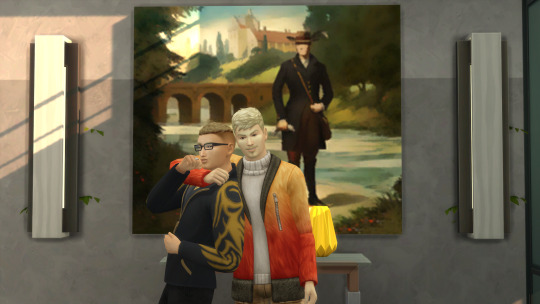
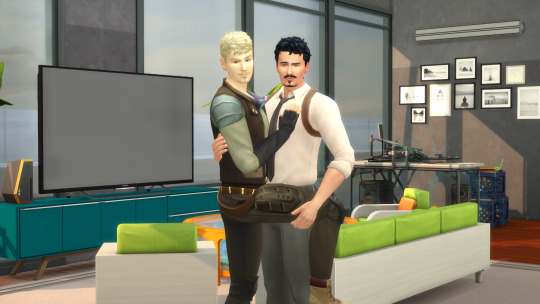
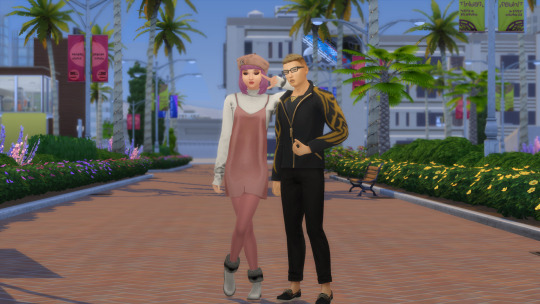

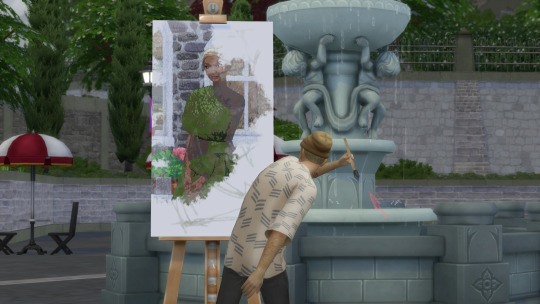
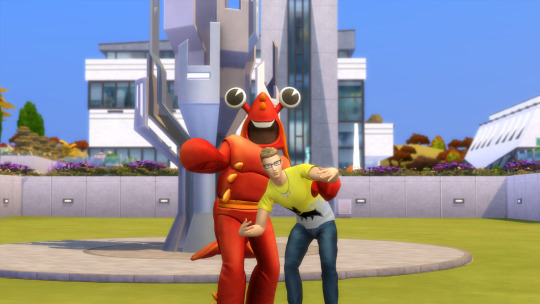


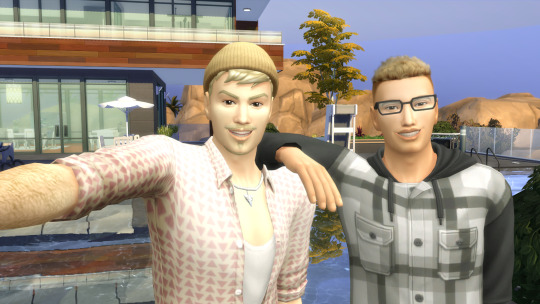
The patriarch of the Doors family is a gallant philanthropist for art and history enthusiasts. He invested and donated a lot of ancient and vintage artifacts for several museums across the globe that landed him a seat as chairman of the board of trustees in the San Myshuno Art Center. He was recognized as a high bidder in auctions, guaranteeing him the rarest items ever sold to people of their class.
Coming from their lavish lifestyle and natural exposure to the arts, the two sole heir, Jon, was inspired to be a name for his own right. A prodigy of the fine arts, Jon started to show excellence in drawing and painting at such a young age. He painted his first masterpiece at seven years old, earning him respect from his father’s colleagues and being featured in his father’s art center digest. From this point on, Jon continued to stride early on his career from a profound hobby and an innate talent. He took interest in pop art culture and took tremendous inspiration from his juvenile imagination. His skills not only brought him the reverence, but brought the same pride to his father for raising an artistic genius as well. In his early years, Jon felt valued for a high price, a masterpiece not even his extravagant father could buy. However, art pieces are fragile and could be defaced by unintended mistakes. In a year, all things changed when he came out as a bisexual when he turned 13. Jon’s perfectly painted canvass of a persona was smeared pink and blue that confused his entire family, and the entire world of his father.
Jon’s father resented him after several of his colleagues pointed out how he failed to be an example of masculinity to Jon. From being an esteemed painter and a talented son, Jon was just another failed attempt of an heir. He was no man to continue the legacy his father built for their name. Jon never cared for that prestige anyway, but he cared at how his father saw him as a person. In his adolescent years, Jon began to know who he really is, establish what he wanted in life and identify with people he felt akin with. His father and mother made him feel like all these new things were wrong, despite their harmlessness to anything but the reputation circling their name. In an array of ancient and valued paintings, there was no room for one that needed extreme restoration.
His mother sent him to conversion therapy in an attempt to reconcile his impurities and bring out the fine art that he was before. Unfortunately for his parents, a couple of weeks in the program did nothing to cleanse Jon of the pride that he was. He was a painting damaged beyond repair so his father did what he deemed worthy of those pieces.
Jon was thrown out.
Despite not finishing his high school years, Jon lived on his own with the mercy of his mother to anonymously buy him a piece of land away from the limelight of his father’s image. From then onwards, all ties connecting him with the Doors were severed. He was never talked of and he was only mentioned to be in a journey to repair himself of his bisexuality. Jon lived alone in Oasis Springs, in a container van he cleaned to be his own shelter. He applied for menial jobs immediately to afford his art materials and start building his career from the ground up. He’d take house painting jobs, sell his works painted on dilapidated canvasses, and even sold on-the-spot drawings at parks. In a couple years, Job gained a following. Locals would stop by at his place and help him around. His people person personality jived well with the locals, placing him in a loving community who cared about him for who he was.
A few more years went by and he had never heard of his family in this long period of time. Fatefully, the Doors were entering a more public eye, being a personality not only to the elites, but also to the lower classes. The Doors patriarch opened scholarships for fine arts students who showed tremendous abilities in the field. Jon could not separate the hypocrisy from his father’s attempt to show some form of charity to other people than himself. In this news, one thing only surprised him; his parents were with a child, a son named Michael, a new heir to their wealth and fame. At the bottom of his heart, he felt bitterness. That was him years ago. Hence, he also felt bad for his brother. From a great distance, he wished him well; to be the perfect son his parents expected him to be.
Several more years passed and Jon already caught the attention of a budding group of artists called Paintre Extraordinaire situated in San Myshuno. They invited him to show them his skills and earn a spot in their tight circle of talents. Jon followed through, showing his works in painting. As an inclusive group of individuals coming from different walks of life, ethnicities, sexual orientation and artistic specializations, Jon was more than welcome to be part of their group. They would meet up every week to exercise their skills and hone themselves further with some activities in the San Myshuno Arts Center. This was the piece of responsibility that scared Jon from the group. It was the center his father used to be affiliated with until he became a curator of the Windenburg Estate. He was worried people who stuck around would recognize him despite being out of the public eye for a decade. He wondered if he should open this up to the group or not, risking his chance of belonging to something for so long.
At first, Jon kept it a secret. At their weekly meetings, Jon wore clothes that did not attract too much attention. He kept to himself. He kept quiet and enjoyed the empowering camaraderie the group had. After a whole day of painting and constructive criticisms, they’d share a dinner, and perhaps an entire night at the club. Weeks of this blended Jon further into the group, introducing these people more into his life and knowing more about them in a different light. He felt obliged to be honest with himself as well. To his surprise, the members did not react negatively nor did they treat him differently. They all saw and agreed that what he went through was beyond what he deserved as a child, or as a son. Through the tightly-knit group, Job found a home where he expressed himself freely, as if he deserved to be loved as much as any straight person should be. For the next meetings to come, Jon evolved to someone more expressive and enthusiastic. From pop art paintings, Jon was mastering painting references and models in the arts center. He wasn’t scared to hide anymore, not even to people his father might be in contact with.
Months later, Jon saw a terrible news on TV. His parents’ mansion in Oasis Springs was burned to the ground after a gas leak explosion. His parents died from the incident. Michael, however, was at a friend’s house for sleepover, far away from their disaster. Instinctively, Jon realized that his adolescent brother would be an orphan and could lose the entire fortune his parents have built from their avaricious distant relatives. He wanted to come into the light and present himself back in the picture, yet he feared that Michael never knew who he was, nor what could people say of him swooping in the light of his parents’ demise. Jon stayed clear for a while, pretending that he never was part of the family. However, his friends in painting circle reminded and insisted on his duty as a brother. This encouraged him to finally introduce himself to Michael who possibly never knew who he was.
The press was bad against Michael. Despite being at a young age, he was surrounded by a lot of people who he was not yet geared up to meet. Jon witnessed his brother’s tribulations online and in the media coverages so he decided to brace himself for that attention and be a brother he never was. As narrated by his parents, he came back to their burnt mansion as a backpacker who just got the news from across the globe. People in the neighborhood were bitter, even the colleagues his father had in the arts center. They accused Jon of not caring at all for his parents’ welfare and even to be pretentious with his self-empowering journey. He was gone for a decade only to come back when the inheritance is available. Those words hurt but those weren’t why Jon came back. He immediately looked for Michael, anxious to tell the little boy who he was. After pondering how to frame his words for him, Jon was shocked when Michael knew him all along. He was an amazing man, a prodigy of the arts, surveying the world for inspiration to craft masterpieces for prestige and philanthropy. Jon was astonished, but that reality gave Michael the most comfort to process what he just had. Jon stuck to that narrative since then.
The funeral and a ton of legal procedures concerning the inheritance and their investments buried Jon in the deep grave of secrecy his parents dug for him. He did not know any of the papers he was asked to sign, but he couldn’t care less. He just wanted Michael safe and secure for the time being. Apparently, his parents’ left most of their money to Michael; including the house, the stocks, and the position at the board of trustees. What was left for Jon were all the paintings and the rarest art pieces his parents have had over the years. At the back of his heart, Jon knew they still cared behind the wall of disgust they separated themselves from him.
With the help of his painting circle, Jon was able to recover his loss, and help Michael get over his. For an adolescent, Michael was seemingly mature. His parents weren’t also the best ones to him. They were both distant and disappointing. Michael grew up alone, wishing his far away brother to come back home and be his lifelong companion. Heartbreaking as the reason why Jon was away, he figured that Michael still deserved to know the truth behind his solitude. He wished no more taint for their parents’ memories, but Jon knew it would also hurt Michael to know that his long-awaited brother would lie to him as they uplift themselves back up. Jon came out to his brother as bisexual. He told him all about his journey alone, and how he met new people who accepted who he was. Being thrown out of your own home was traumatic and cruel, but Jon’s hope to meet new and good people did not disappoint him. To his surprise, Michael had no reaction to his confession. He just offered his comfort and reassurance that their house was then a safe space for the them both.
The same conversation, Jon knew Michael was only his half-brother. After the Doors kicked Jon out, Jon’s father was so desperate to have a new heir. His mother was not. Michael was born out of marriage with another woman his father paid to conceive a child with. Out of shame for their name, the Doors kept the entire pregnancy a secret nor the identity of Michael’s biological mother for an incredibly large sum of money. Upon discovering the truth, Michael did not bother to search for his true mother. She was already erased from history and she had eluded the narrative herself for a fortune. Michael had been alone for years, feeling he never fit the position he was born for. Jon, his long lost brother, was the only chance at family he had for years and now that they found each other, it all felt well to start from the very beginning and rebuild their name under their brand.
Michael took up fine arts in college and pursue his dreams of being a music producer. Jon, on the other hand, continued to live his vocation to painting. Having more resources, Jon expanded his passion to greater lengths. He’d paint several pieces at a time and be able to sell each at an extravagant price. He was even commissioned to paint the royal couples and all the winners of Miss SimWorld and SimUniverse. With all his earnings from his works, he overcame his parents’ fortune and relieved himself of the burden of relying on their inheritance money. Jon may have lost all his fathers’ colleagues’ trust and support, but he had his talents and his friends to elevate his name back up again in the spotlight.
Jon and Michael were children of a supposedly predetermined fate in the hands of what their parents, or society deemed was right. Their boundaries were restricted to fit what was expected of them as they go on in life. Jon’s defiance was met with hostility, and Michael’s compliance was prodded with a projected identity. It was later in life that they had an opportunity to explore who they really are and who they wanted to be, but from that point on, they had an anchor to where they began, rather than chains that stopped where they could go.
In those first years they spent together, Jon and Michael met people they might soon welcome into their family. With no pressure or whatsoever, it still felt difficult to make decisions that could affect their lives forever. Nevertheless, those consequences are for their lives alone, and not for anyone else anymore. It was part of the life they were supposed to live and that is the leap they never had done before.
0 notes
Text
A Brief History of BRASS

July 2016
It was a typically gorgeous Vancouver morning and I'd skateboarded over to meet up with Devon Motz, the acerbic lead singer of the East Van punk band-BRASS. I'd been with him less than sixteen hours ago as we dropped off the rental van that the band had used for the ten-day tour to Edmonton and Calgary that preceded us. Devon and I met up at the CannaClinic Dispensary in the Hastings Sunrise neighborhood of East Van before stomping down past industrial meat processing warehouses and breweries to Rain City Recorders. The band's drummer, the mohawked and mustachioed Rory Traughton, was already waiting for us, rubbing his temples while slouching into a deck chair next to a glass table top adorned with ashtrays and empty beer cans. Devon passed me the grass and I went to work twisting up whatever heady indica he had purchased as Tristan Milne, the lead guitarist, appeared with a Pall Mall clenched between his grinning teeth while he toted two guitar hard cases, one shaped like a casket, in either hand. We fired up the joint and before long the bohemian bad boy bassist Eric Campbell appeared his single hanging ear piercing swaying around his frizzing out of place hair. We all smoked, got into some morning beers and enjoyed some sludgy memories and howl inducing stories of the past week of tour which, for the sake of everyone's reputation, I frankly can't tell you anything about.
BRASS was there that day to begin recording the follow up to their 2015 punk rock party primer cord: No Soap Radio. Over the following year and a bit, they'd seen their original bass player depart and had picked up their friend and contemporary Eric Campbell after he'd filled in during a couple of tight pinches. Now after nearly a year of playing and writing together, the band was ready to lay down tracks with the same engineer who'd helped the sonically economic quartet package their first disc, Jesse Gander. In Vancouver, Jesse is something of a legend having produced hundreds of albums in his over fifteen years of experience including Anciients, Baptists, Dead Quiet, Japandroids, The Jolts, Bison, The Pack AD and many many more. Given BRASS’ reputation in those days for starting sets rowdy and ending bloody when they had gone into the studio in 2015 for No Soap Radio, Jesse had been surprised at their polished and 'get r done’ approach to recording. Aside from regularly crushing volcano bags of weed and the standard amount of whiskey and beer BRASS had done the work pumping out their debut LP which would eventually be named by Canadian publication Beatroute: Vancouver Album of the Year. From here a cross-Canada tour was planned and started but the band didn't make it halfway before their van decided to light on fire a couple of times, before the band was badly hustled by a mechanic in the sinkhole known as Vagerville, Alberta. This ended any dreams of success out East. In the chaos that followed this disaster, the band lost their original bass player in a truncated crash and burn scenario before they picked up Eric who happened to be touring in tandem with his psyche rock corps Eric Campbell and the Dirt. Over a year later the band was going back into the studio with a whole new bag of tricks and tracks, even if some of them weren't completed.
Jesse arrived, hauled a few hard drives out of a safe and let us into the studio where each of the musicians took turns setting up their individual rigs to be separately microphoned for the bed tracks. These initial recordings would provide the rough sketch of the album used to write the thing as a whole. While Rory set up his drums, the longest job, Devon and I took refuge in the living room perch above that had a glass window that looked down on the recording floor. Devon's pretty good at playing Tony Hawk Pro Skater 2 on an old PlayStation 2. Since Calgary Devon had been remarking that he hadn't completed lyrics for several of their new songs and now almost a week later he didn't seem any more concerned by the prospect of going up to the mic and winging it. Almost two days later when I pressed him on his approach to lyrics he'd said "My lyrics don't mean anything man. They don't have to, that's not how I do it." At this, I rolled my eyes because whether Devon knew it or not at the time his lyrics are a cacophony of metaphors for wonton self-annihilation or distaste for the establishment presented through a shit-eating grin or displayed on a tasteful summer dress. It appeared that the band's approach to recording the new album was to play it fast and loose, rolling the dice on some of those new tracks to see what'd come up on the day of. A gutsy move considering how much the recording and mastering had cost them. The majority of that first day was spent working Rory like he was a mule you rented on someone else's dime. In the days that would follow the rest of the band would take their shots at putting down the masters for their individual portions of the record, but first, they needed the hardest tightest drum tracks to follow along to. After the first 25 takes Rory, who has to try really hard to take it slow, was starting to get gassed out but the whole band soldiered on.

Don’t wake up Rory ya doof doof.
During a smoke break, we gathered once more on the patio and that unique flavor of East Vancouver, the warm air carrying the scent of chicken and fish rendering, barley mash, and hot garbage cut through the air causing us all to choke and laugh. Someone remarked that it was a true East Van Musk and so the throat kicking banger from the new album, formerly titled Something Heavy, was renamed EVM. That first day the band hammered out the beds on ten songs, at least 3 of which they didn't have completed before they went into the studio. Devon, in daring fashion, had whipped up some lyrics when we weren't looking and filled the voids in the tracks. I couldn't imagine so instinctively writing something which would instantly become so indelible. Despite knowing a number of the songs, I could only hear pieces of the album. It was like a puzzle where only a few varied blurry shapes are visible, but no distinct image. Tired, kinda drunk and ready for bed we all agreed to meet up the next day, same BRASS time same BRASS channel.
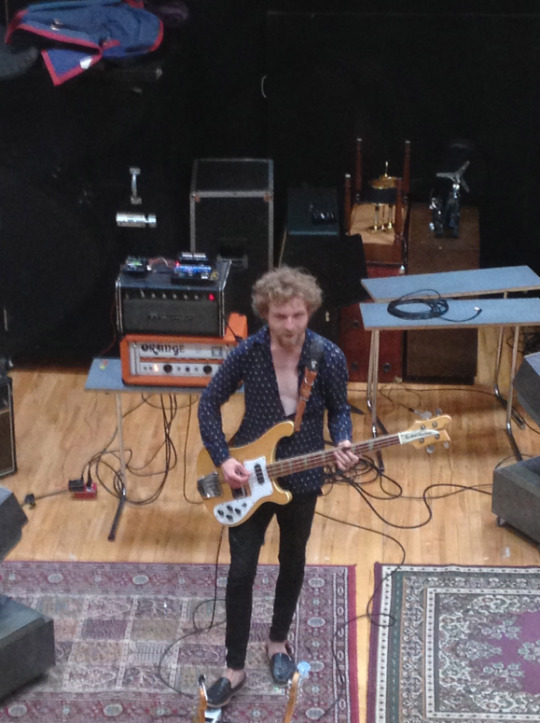
Eric Campbell, Aka Local Creature, Aka Vampire Twink
When I got to the studio the next day Rory, Devon and Eric were already there. They told me that Jesse had been biking to the studio and was hit by a car and had broken his shoulder blade and his wrist. The band's consideration for Jesse was number one, but there was still the choke of frustration for the situation itself, a nagging reminder of the random cursed disaster they'd incurred in the form of their tour ending van fire. The vibe was fucking grim. The assistant engineer Mark Mckitrick had been instructed to let the band do as they needed to without Jesse. Years ago Devon and Tristan had earned degrees in audio engineering from now-defunct Pacific Audio Visual Arts Institute and all members having been through the process of putting down a record said fuck it and stepped up to the plate. The microphones in the room were already set up to their specifics, so Jesse or no Jesse it was time to do the work.

They trudged through the remainder of the bed tracks before Devon and Eric stuck on the floor going through some piano overdubs for songs I didn't know yet. Not long after that local gun for hire violinist Emily Bach appeared and put down some time and sound for the gang. I was starting to see this jigsaw puzzle taking shape. I had seen and heard many of these songs in the past, whether at shows or when hanging out with my friends in their jam space, but I had never seen the true assembly of art such as this. This was, aside from musical talent, an artistic production. A construction and curation of all of the best juicy bits and ideas that the team had been working on for the past year. Watching the different layers of overdubs come together was like realizing an idea for the very first time. It wasn't just some patently repetitive follow up to their succinct debut punch to the sun. This was becoming something that stood aside from what the identity the band had carved out for themselves musically and personally Their reputations aside, their character was starting to show. Rory and Tristan were the last people at the studio that night and I left them with a full deck of smokes and a bottle of whiskey.

That third major day in the studio Tristan sat in a chair, tuned up his guitar and laid down his parts for each and every one of the songs. In the background, Devon was already sipping whiskey, Alberta Premium: Dark Horse, and getting ready to rip his throat apart with his far-ranging, high-frequency feral singing. Devon screamed into his mic, standing behind a partition so he didn't have to look at our stupid faces while he yelled his guts out. I still managed a picture of him. By the time Devon was done with all his vocals, his voice didn't seem too bad but the bottle of whiskey he'd been drinking from however was just 'bout 'bliterated. Jesse had made it out of the hospital and damn trooper that he is, he arrived at the studio. He was gassed on X amount of high-quality painkillers and I'm sure he remembers very little about that day, but he was there goddammit. It was Jesse that presided over the board while Devon proceeded to take his pants off and direct the assembly of friends who had arrived to provide gang vocals for several of the album's tracks. It wasn't long before every member of BRASS was sans pantaloons, the weight of the past two weeks of touring, playing and recording catching up with them at all at once. As they stood directing the East Van Brass Choir it was clear that all four of them were gooned on life. Devon being a prick on purpose catalyzed all of their attitudes as they liberally indulged their sense of trouble-making tomfuckery. Tristan, no pants had his eyes closed grinning while his hands conducted us. No one really cared. It was to be expected after enduring this far on such little sleep, fuelled only by the misting remnants of that pure golden tour energy and about a whole ounce of weed a heck of a lot of beers. What else could you expect from those who have just extracted the power of the gods out of the ether? Remain composed? What would you have them do? Aside from some mastering and tinkering the overdubbing the album was finished. Due to Jesse's injury, it would be a couple of months before the masters would be ready.

I was lucky enough to be passed a copy of the initial masters not long after the band received them and it became my unofficial skateboard anthem and stoke machine for the entire next year. I felt that it was a triumph, a total package that showcased the group's artistic diversity, emotions, opinions, and hunger. It meant a lot to me, it impacted me and changed how I felt about not just their music but that of the community around me as well as my own art. I couldn't wait for the world to listen to it.
April 2018
Rory, Tristan and I stood around behind the Cobalt Motor Hotel leaning on Rory's truck smoking cigarettes with a few friends waiting to see if it was going to rain. Devon was on his way there. Claire was on her way from work. That night was the release of the album that the band had recorded almost two years earlier. A lot of things had changed.
Since BRASS had finished recording the album that would come to be known as: For Everyone, things had changed. Summer 2016 had become autumn and our world had shifted out of the golden crispy Vancouver summer into the black-lit, high precipitation Blade Runner metropolis that Vancouver is known as. Over the past few years our scene, as it were, had largely orbited around a street level promotions group called Art Signified who had developed their reputations as tastemakers and animals. After enough basement shows, haggling with the sparse difficult Vancouver venues and throwing some of the best all day hardcore and punk parties Vancouver has ever seen, Art Signified had managed to secure a location in Vancouver's Chinatown to be used as an all-purpose arts and culture space. They named Studio Vostok, after Vostok 1 the first manned space vessel. Operating as a legal space Art Signified soon discovered just how crushingly expensive the antiquated Vancouver permitting systems are as well as the City's oppressive by-laws which make it nearly impossible to run an independent space that presents loud live music. Despite the fact that the mentally ill and addicted of Vancouver's infamous Downtown East Side were dying of fentanyl laced overdoses by the truckload, the Vancouver Police Department came down harder enforcing Studio Vostok's, and other space’s, bylaw infractions than they did on any peddler of hard street drugs. If you live in Vancouver it's clear, the only art and culture that our City wants is the kind that tows the right line of appropriateness and doesn't make a mess. Vancouver likes to proclaim itself to be an artistic City but the arts that thrive here often are either backed by some big dick money or appeal to our obnoxiously flaccid and bland brand of nationalism. Still, months of loud music, underground shows, literary events, movie screenings, public games nights, roundtable forums on social issues, music video shoots and greasy all-night chain smoking beer crushathons in the fight club basement led to the inevitable closure of Studio Vostok in February of 2017. The closure of the now mythic space, which had been our temple of Sodom for a time, precipitated a momentous shift in our scene. The godhead gone other avenues would need to be pursued. One of the most important changes for BRASS was that Eric Campbell had decided to take his leave, packing his bags and heading east to Montreal in search of a folk singer cage match in the artistic mecca of Montreal.

Photo courtesy of Alex Slavin
Enter Claire. Claire "Twitchy-Twitch" Carreras had been a mainstay in our circle of miscreants over the years, in fact, her badass track record pre-dated all of us by at least five years. Before they ever met her Devon and Tristan had been obsessed with her corroded battery acid female punk group Joyce Collingwood, in which Claire played lead guitar. Joyce Collingwood had since disbanded and Claire had joined forces with local pain in the ass and idiot savant Taya Fraser to form the head-butting hardcore duo HEDKS. Claire fucks. She fucks harder than you any day of the fucking week. When it was clear that BRASS was going to need a new bass player she was at the top of the list. After a couple of months of practice, learning the reasonably large catalog of songs, it was like she'd been in the band the whole time. Claire's logical head and lack of capacity to endure time-wasting bullshit is mirrored by a desire for mayhem that has the potential to eclipse just about anyone else's in the band.
The album had been done for a while, BRASS performing almost all the new songs spread out across the gigs of the past twelve months. There had been talk of going to SXSW in Austin, Texas to attempt getting signed to a label, but due to visa arrangements and general finances, it just wasn't in the cards for BRASS. Distribution for the album seemed a conversation that none of the band members wanted to have, at least not initially. What BRASS does first and foremost is put on a show. Some of that show is for you, the audience, but most of that show is for them. When they get buck they are getting buck. You feel it and you know it's real and you wanna let your shit go off. When they play it's like, uh actual art dude. They hadn't always been there though, they had evolved over time. Gone were the juvenile sneering bloody-faced affectations of a bunch of angry young men smashing through each other while spitting beer in your face and stealing your girlfriend. Through some dense alchemy they had melted and transmuted their form three times and each time it settled it was miraculously cast with a renewed energy, accented with the distinctions and elements of their own maturing character, but also with a refined punk sensibility that always pisses some people off: intelligence. In the past year and a half, they had been trying to figure out what they were really worth and how much they were willing to give up to get what they thought they wanted. I think for a good while there they just decided to say fuck it, ignore chasing labels and keep doing what they do best, which is perform and make new work. The things that most artists should be preoccupied with.

Photo courtesy of Taya Fraser
With no plans to release their album, nowhere higher to go without serious financial support and good-natured itch for adventure BRASS made plans to conqueror Europe. They went. The details of this trip I don't have because I wasn't there. But much like any other tour, even if I did have that information I'd probably never tell you. In their time as a band BRASS, as previously stated, had gained a reputation for pushing the envelope and fucking shit up, so upon returning from Europe friends and fans badgered them for tales of their exploits in the old world. As I'd come to understand it, almost everything that happens on tour is a ‘you had to be there’ situation, so why bother trying to explain that joyous madness to someone who was not going to, or even didn't deserve to, understand it. Maybe they'd tell you about it, but I wouldn't ask.
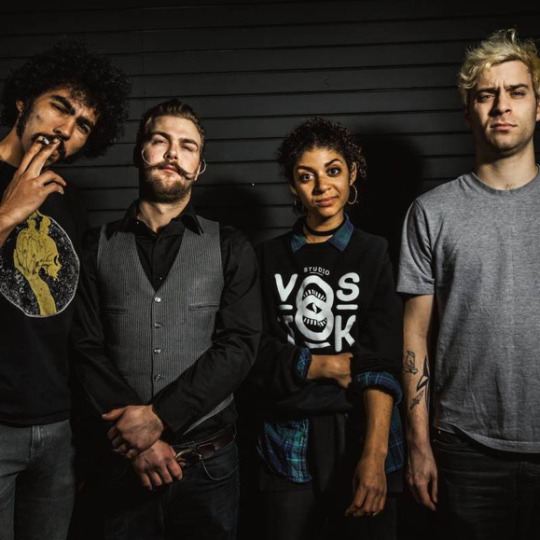
Photo courtesy of Asia Fairbanks
We'd finished smoking our cigarettes and dragged Rory and Tristan's gear inside just as the grey early spring sky started to spit at us. Inside the venue, I was so damned pleased to see Eric Campbell, having only days earlier returned from Montreal where he'd been for the better part of a year. The band began to arrange their stuff for sound-check and I made chit chat with Emily Bach, the gun for hire violinist, before Tristan and I went for some chicken sandwiches up the street. When we returned to the venue Devon was there setting up the merch table with CD's of For Everyone, the clear with pink swirl vinyl for No Soap Radio, buttons, stickers and a menagerie of their most recent run of tank tops and t-shirts. While Tristan and I sat in the green room eating our sandwiches before intermittently glugging from a bottle of absinthe I thought about how many different shirts the band had made over the years. The past few years had seen the slow dissolution of aspects of our scene's foundation, the closure of venues and the troubling derivative or exploitive environment of Vancouver music, the process of getting older and growing up yet BRASS is still standing. 2013, when the band had formed, was a long way off. Had we gotten old? It was during this time waiting for the show to begin that I watched each of them in passing, seeing a pause of consideration on their faces. For five years, after however many gigs, festivals, tours, bass players, fist fights, stupid decisions, all-nighters, torn dresses, trauma, heartbreak, black eyes, broken guitars, bottles of wine, cases of beers, broken glasses, packs of burnt darts, laughs, arguments, meltdowns, snapped strings and lost tempers, they had survived without becoming cliche rock and roll suicides. Their desire for recognition and achievement had never diminished but in all that time I'd never seen them compromise their integrity or artistic choices for the sake of getting another rung up the ladder, and had, in fact, witnessed them go the other way; expressing disdain for star fuckers and sleazy opportunists. I'd watched them through times of plight and been lucky enough to bask in their successes. No part of their repertoire, no matter how intense or foolhard, felt dishonest to me. No part of it felt contrived. Their moments of artistic sensationalism or provocation were not simply indulgent wankery, it had all come from a place of individual intentions and style that when re-forged through musical metallurgy created the unique alloy of performance that is honest and righteous in its provocation.
After nearly two years BRASS, with the prodigal Eric Campbell and the gunslinger Emily Bach, stepped out onto the stage to finally released their intelligent, caustic and heart-wrenching sophomore album, a gift from them For Everyone.
Listen to For Everyone and No Soap Radio.
You can follow the band on Facebook, Instagram, and Twitter.
Watch the hard-hitting two-song music video for "Disco" and "EVM" from For Everyone here.
Axel Matfin wrote this. You can visit his website and follow him on Instagram.
Follow DRM on Facebook, Instagram, and Twitter.
#brass#brass vancouver#punk#punk rock#feature#axel matfin#vancouver#vancouver punk#vancouver punk rock
1 note
·
View note
Text
Right People, Wrong Timing: RETHINK WHAT YOU NEED TO DO (Interview with Dinh Q. Lê on Untitled Space)

RETHINK WHAT YOU NEED TO DO: Interview with Dinh Q. Lê on Untitled Space (Sài Gòn, 2005 - 2006)
From 2005 to mid-2006, artist Dinh Q. Lê ran Untitled Space, a residency project that invited various artists, curators, and museum directors from all over the world to give talks in Sài Gòn, Hà Nội, and Huế. Around the same time, Lê also co-founded the Vietnam Foundation for the Arts (VNFA) to help fund Untitled Space and Lê’s next project, Sàn Art, which he co-founded with Tuấn Andrew Nguyễn, Phunam Thuc Ha, and Tiffany Chung in 2007. In this interview, we discuss the reasons behind launching these initiatives and the numerous challenges he faced through the years.
*****
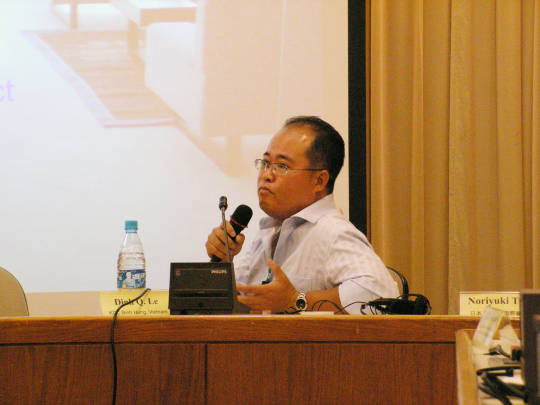
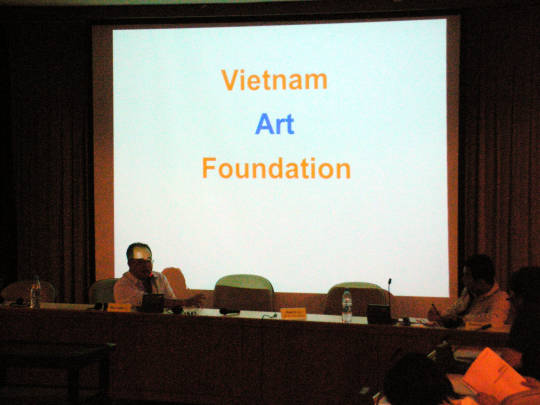
STARTING NETWORKS AND PROJECTS
Merv Espina (ME): I think one of the take-off points for the Right People, Wrong Timing series was Intra Asia Network (IAN).
Dinh Q. Lê: I think it was really a wonderful time because it was the first time we all gathered together. We met each other through that network. You know how it started, right?
Norberto Roldan (NR): My recollection was that Margaret [Shiu] started the first meeting in Taipei [in 2005].
DQL: Yeah. But before that, there was also something else.
NR: The one in Berlin [in 2005] coincided with the Res Artis International.
DQL: Yeah, so basically Rockefeller Foundation gave Res Artis funding to start reaching out to Asia because Res Artis was primarily a European organization. Clayton Campbell was the head of Res Artis at the time and he reached out to Rockefeller to see if they could get funding to expand their network and bring in partners from Asia. They got the grant from Rockefeller and they invited me and Margaret to be advisors for them.
Res Artis and their European members were so different from the Asian partners and organizations. Because in Asia, particularly Southeast Asia, most of us are independent and self-financed. We don’t get funding from the government. So, the two were so different that there were a lot of complicated feelings. We were all questioning, “why should we pay Res Artis”—I believe it was 100 or 150 euros a year—“to be a member when we could do a lot with that money in Southeast Asia?” There was a lot of interest in starting our own network rather than have to pay a fee to Res Artis to be in a network that primarily catered to a more European residency program that, most of the time, was fully funded by their own governments. It was very different from our organizations here in Asia and Southeast Asia. That’s how Margaret decided that she was going to start IAN.
ME: But prior to that, how did you get involved? How did they select you and Margaret?
DQL: I had a long relationship with Rockefeller even before 2005. They came to Vietnam in 1999 and asked me if there was anything they could help with. They came with, I think, the Ford Foundation and Asian Cultural Council (ACC) people. They travelled around Vietnam and they came to my studio and basically asked what they could do to help and I told them that Vietnam needed information about contemporary art. The schools at the time didn’t really teach contemporary art. Everything they were teaching was up until 1950 and it sort of ended there.
So, I proposed that they fund a reading room. Contemporary art magazines would come in monthly and artists could just go in and look at them and, if we had funding, we could even try to translate some of the important articles, or they could browse just to have a visual idea of what’s happening with contemporary art outside of Vietnam. The Rockefeller agreed to give me $35,000 to open the space.
The problem was that I couldn’t get the $35,000. The Rockefeller had this policy where they could not give the money to individuals, only to non-profits or governmental organizations. The problem in Vietnam is that I cannot set up a non-profit even today because the law is so badly designed that we cannot open such.
I asked some of the governmental organizations like the Fulbright Foundation here to be the grant recipient but they refused because contemporary art for them was controversial. Some of the local Vietnamese government-run organizations wanted a large percentage of the grant but I was not willing to hand over 30% just so they would be the fiscal sponsor. In the end, we lost the grant. That was a big frustration and it, in a way, led to me opening two other organizations later on.
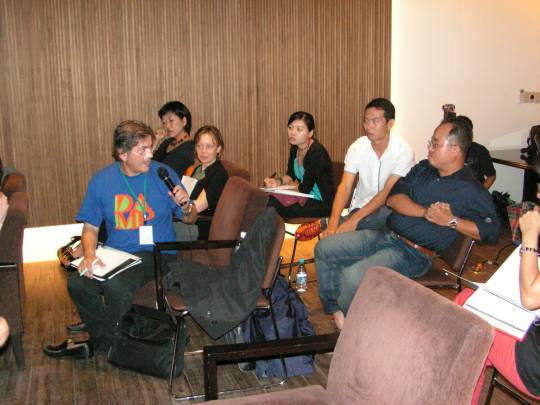
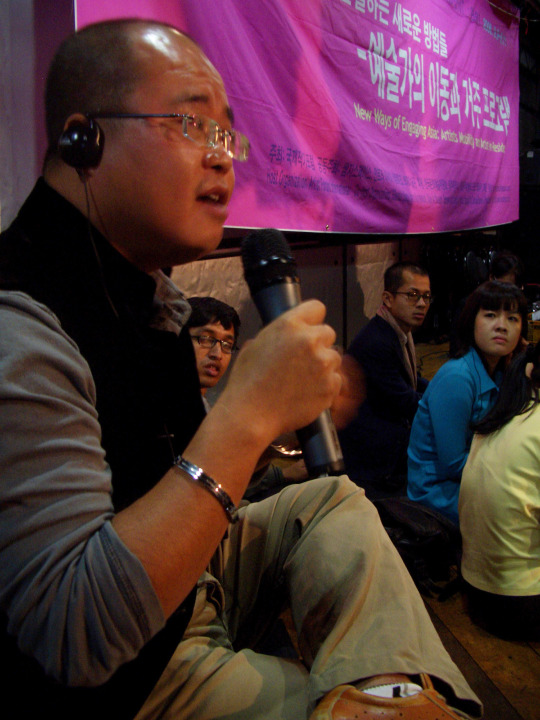
THE VIETNAM FOUNDATION FOR THE ARTS
DQL: So, partly out of the frustration of not being able to get money from the Rockefeller Foundation before, I opened the Vietnam Foundation for the Arts (VNFA) in 2005 with my dealers in Los Angeles. It was a way for us to have a non-profit status so we could apply for grants like that. I think we got five collectors from America to be on board and a few museum directors and collectors as well. They would each give $5,000 a year to VNFA, and so, in a year, we would have around $30,000 to do programming in Vietnam.
At the same time, I just built my house. Because I have a lot of relatives in America, I figured I’d build it big so they could visit during the summer. But, during the school year, the place was not being used so I thought of opening a residency. That’s how Untitled Space opened pretty much around the same time as VNFA.
It was the first organization that I opened so I was a novice. I had no idea how to run an organization and it was not an easy task because, at that time, I was also very busy with my work as an artist. I was showing quite a lot.
I think my dealer was also afraid that running the residency program would take over my life and I would not be able to operate as an artist. But that’s how it was designed: Untitled Space was a by-invitation-only residency program and VNFA would pay for the people that we invite.
UNTITLED SPACE
ME: Who was the first? How many residents did you have?
DQL: First were Shirley and Sara Tse. Shirley represented Hong Kong at the Venice Biennale 2019. I collected some of Shirley’s work before so I invited her and her sister to come and talk about their work. Then we had Moira Roth who is a historian who lives in Berkeley, California and teaches at Mills College. Her expertise is on performance art in the West Coast, in California.
Shirley and Sara Tse came and talked about their work and practice while Moira Roth talked about performance art. I remember the reason we brought Moira was because Vietnam at the time didn’t know what the hell performance art is and, in Vietnam, every time you do an exhibition or a performance, you have to get permission from the Ministry of Culture. They didn’t know what a performance was. They thought it’s theater. We had to explain to them that it’s not theater because they kept sending us over to the Theater Department to ask permission.
Moira gave a talk about performance art in Sài Gòn and we flew her to Hà Nội to give a talk as well. The people from the Ministry of Culture actually came for the talk and they came up to her after to thank her and that was really kind of interesting because she actually showed a lot of images of very provocative, sexualized performances with nudity and yet, all these officials came and sat through the whole thing and that was really kind of funny.
We also had Catherine de Zegher who was the head curator of The Drawing Center in New York. She spoke about contemporary drawings. Vietnam has a very strong tradition of drawing. Many of the artists in Vietnam are extremely well-trained when it comes to drawing. They draw beautifully and their skill is amazing, but they’re still very traditional types of drawing.
When we brought Catherine de Zegher to talk about drawings, she started out with a work that’s still quite interesting to me: a work by Gabriel Orozco, this Mexican artist who I think lived in Paris. It’s a photograph of him riding a bicycle through a puddle of water and the wet mark of the bicycle wheels on the pavement going round and round and round. She called that a drawing and I remember all the artists that attended the lecture were so upset with her because they were like, “that’s not a drawing!” They started to get really angry but that was the point. The point was that drawing can be more than just pencil-on-paper. It gave them something to think about and that was good. [1]
NR: Were you hosting mostly artists and curators from the US?
DQL: Yes. At the time, my network was in America. I didn’t have much of a network in Asia. I think many curators and museum directors and even artists in Asia thought of me as somebody still living in America. I think it was when I opened Sàn Art that people realized that I actually had been living in Vietnam for a long time.
ME: Why “Untitled Space?”
DQL: Whenever I make a work, I don’t think of a title. It’s always at the last moment when the gallery asks me, “so what’s the title of the work?” that I scramble for it. I’m still kind of fond of the idea that I don’t think about a title, it’s just something that I do, and to give it a name is something else. Also, I like this idea of “untitled” because the space was the first time I was doing kind of a community art space. I was a novice and I didn’t know how it was going to function. I didn’t have a staff and I didn’t know much about anything so I didn’t want to give it a name yet, basically.
ME: You didn’t have staff? It was only you?
DQL: That was a problem.
ME: And you ran it from 2005 until 2007?
DQL: I think we stopped at around mid-2006 because it became a bit too much for me because curators and museum directors would fly in and then I would fly with them to Hà Nội to organize talks at the fine arts university there and, if they had time, I would also take them to Huế to give a talk at the university there and then to Sài Gòn. It really took a lot of time for me to do all this and I think, at some point, I realized I could not do this forever. It was just too much. It takes too much time from my studio work. [2]
I also realized that, in Hà Nội, the art scene was quite active because all the NGOs and embassies were there and so they got a lot of foreign funding. In Sài Gòn, there was zero funding. There was really nothing happening in Sài Gòn.
That was the reason why after a year-and-a-half of running Untitled, I thought we could use the 30,000-a-year funding we had with VNFA to open a contemporary art space. We stopped using the money to invite international figures to open a space where local artists can experiment with all these new forms and ideas without having to rent a gallery and pay a certain amount when they don’t have the money. That’s how Sàn Art opened.
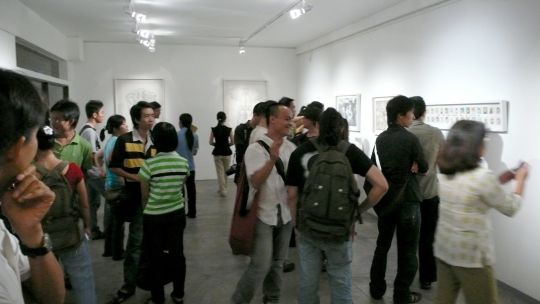
SÀN ART
NR: At some point, you decided to close Untitled because it was taking up so much time from your studio-
DQL: Yes.
NR: But then you started Sàn Art.
DQL: Well, after Untitled Space, I became a little bit smarter. I asked Tuấn Andrew Nguyễn and Phunam [Thuc Ha] of The Propeller Group and Tiffany Chung to come in and collaborate with me. Now, the work is divided into four and we also hired a gallery manager to do other things. We would take turns curating the shows. It worked much better as it wasn’t solely me running the space.
ME: Between you stopping Untitled in the middle of 2006 and starting Sàn Art [in 2007], why was it so short? And what told you to restart it again and what were the lessons that you learned from running Untitled Space? What were the mistakes you learned from that you applied to running Sàn Art?
DQL: The idea was to stop Untitled but not to stop working with a community entirely. We needed the six months to plan out and strategize how Sàn Art was going to be because I knew that when I stopped Untitled, it was to open Sàn Art, an art space for young artists. It wasn’t like I stopped and then thought, “what next?”
ME: So you already had the idea for Sàn Art when you stopped Untitled?
DQL: Yeah, definitely. We had the funding and there was a need for a gallery space for experimentation. So, I stopped Untitled and, I have to tell you, my board members at the VNFA were not very happy with that idea.
But in the end, they saw the logic of it so they reluctantly agreed to stop bringing in international artists, curators, and museum directors and transfer the money to fund Sàn Art. There was never a plan to stop, but just to basically transform Untitled into something else. In terms of lessons, definitely find people that you like, people who are capable, and work and collaborate with them. That was the big lesson: you could not do things alone.
ME: So basically, Sàn Art inherited a lot of Untitled’s networks.
DQL: Yeah. During the first three years, funding came from VNFA. We didn’t have any other funding source. That’s how we were able to pay our rent, pay the staff, and get the funds for artists to create exhibitions at our space.
Three years ago, Sàn Art went through a really difficult time because we had this major grant from the Prince Claus Fund and when that grant ended, Sàn Art went broke.
ME: But didn’t you still have VNFA?
DQL: No, VNFA now... this is one of the big problems I think for any organization: the funders’ interest slowly moves elsewhere. They don’t give forever. For the funders from VNFA, eventually, their interest moved elsewhere so right now we actually are on our own.
When we got the big funding from Prince Claus, it was a three-year funding and was something like $350,000, which is a lot for three years. We had around ten staff members, three buildings that we paid rents on, and when that grant was over, there was no other grant to replace that and we basically collapsed. I had to let everybody go.
So, for a while, we had a little office space. The whole process was to try to rebuild again. But we’re okay now. We have an 80-m2 space in pretty much the city center. We’re also selling artwork a bit too and it’s actually working, although we still have to focus on that a little bit. We also apply for grants here and there. Also, our operation is very small so the budget is manageable now.


CYCLICAL PRACTICE
NR: How much are you involved with the operations of Sàn Art today?
DQL: I’m more of an advisor and kind of an architect in a way. Right now, we have a completely new team and they’re young, they’re very good. They all received scholarships to study in America and elsewhere, and they all came back which is really wonderful. It’s a whole new generation of young people who are interested in the arts.
What I see happening now with Sàn Art is that it has become more of a space to train young curators or art administrators. I don’t do the day-to-day running and programming. The team pretty much does the local artist programs and, starting last year, we discussed a 50/50 program: 50% local and 50% international artists. We were planning to do an international program but the pandemic happened so we have not been able to carry it out.
It’s fascinating in a way because, in Vietnam, the art scene is so small that an artist would be showing in so many spaces within a year and, after a while, we’re all competing for the same artist. So, we thought, why don’t we go outside of the local network of artists and focus on bringing really interesting artists to Vietnam?
ME: It seems a bit cyclical because Untitled had a lot of international networks and then the first few years of Sàn Art were quite local.
DQL: It’s true. In the beginning we wanted to bring in information about what’s happening outside Vietnam and then, when we opened Sàn Art, we wanted to support local artists and help nurture their talents by giving them a place to experiment.
Now, we have a lot of spaces in Sài Gòn. Many of the artists that we trained through Sàn Art are now showing everywhere and so we feel that we’ve done our job. We have trained a good number of artists and the art scene is vibrant now that we don’t have to focus on the local artists anymore. We can now also think about Vietnam and how to connect it back to the rest of the world.
SBY: Can we say that, from Untitled to Sàn Art, the role that both spaces have played is to stimulate the growth within the scene? Whether by bringing in international practitioners or even just cultivating the local talent? So, as Merv says, it’s cyclical in a sense that you are actually gauging what is important and necessary for the scene?
DQL: Yes. You know, I was born in Vietnam, left when I was 10, ended up in America, grew up, went to school in California, and then I did my master’s in New York City. In New York, the art scene was so vibrant. Everything was happening. Then, in [1993], I came back to Sài Gòn for the first time and there was nothing happening. The difference was so drastic that I felt I had to do something. By 1997, I decided to live in Sài Gòn full-time.
At some point, I felt it was necessary for me to create a community because I needed a community and I think the rest needed a community to be together, people with like minds, to think together and to support each other. So, yes. Every decade or every five years, you really have to rethink what you need to do. It needs something different. It changes.


POSITIVE DEVELOPMENTS
ME: You’ve been dealing directly with government institutions with all these projects. What do you see are the positive developments of you having to constantly deal with these since you started?
DQL: Do you remember Saigon Open City and how it was censored and the whole thing collapsed? So that was the frustration because the government didn’t know contemporary art and they didn’t trust it because it was something they didn’t understand.
So we thought, let’s open Sàn Art and, every month, we have to engage with the Ministry of Culture for permission to the point that they get used to us and to contemporary art, and basically prove that it’s nothing so threatening for them to be so worried about.
It’s almost 13 years now since Sàn Art opened. We’re still around. Besides the fact that we went broke, the government hasn’t tried to shut us down so I guess they’re used to us now. I think, for them, contemporary art is not so strange and scary anymore. I mean, they could shut us down anytime. Now, they even gave me my Vietnamese passport back. Before that, they could kick me out of the country anytime if they didn’t like what I or Sàn Art was doing but they didn’t.
Of course they’re still nervous and every couple of years we have a new crop of bureaucrats who are running the Ministry of Culture so it’s a bit frustrating because we have to re-train them in a way for them to get used to what we’re doing. But we have been around for so long that I think that they think what we do is somewhat normal now, which is kind of great.
ME: You educated them.
DQL: We either educated them or we just wore them down.
*****
[1] Other guests include Jeremy Strick, Melissa Chiu, Alma Ruiz, and Carolee Thea.
[2] In a later conversation, Lê said they would be flown to Hà Nội and he would fly up to meet them there. The guests would usually stay for about three to five days in Hà Nội, spend another three to five days in Huế, and then fly to Ho Chi Minh City and stay for another three to five days, all depending on their schedule. Many did not have the time to visit Huế.
The online interview took place on 16 August 2020. This interview was edited for length and clarity.
*****
Dinh Q. Lê was born in Hà Tiên, Vietnam. He received his BA in Art Studio at UC Santa Barbara and his MFA in Photography and Related Media at The School of Visual Arts in New York City. In 1993, Lê returned to Vietnam for the first time and in 1997, settled down full time in Ho Chi Minh City. Lê’s artistic practice consistently challenges how our memories are recalled with context in contemporary life and his work has exhibited worldwide.
Images:
1. Lê, seated between Ly Daravuth and Noriyuki Tsuji, presenting on Untitled Space during the 2005 Pilot Project AIR Asia - Mapping Asian Artists’ Mobility, better known as the first IAN meeting, in Taiwan.
2. Lê presenting on Untitled Space in Taiwan, 2005.
3. Lê presenting on VNFA in Taiwan, 2005.
4. Day 2 of 2005 IAN meeting in Taiwan. From L-R: Nicholas Tsoutas, Ly Daravuth, and Lê.
5. Lê speaking during the 2006 IAN meeting in Seoul, Korea.
6. The opening of The Future at Sàn Art’s first space along Lý Tự Trọng, District 1, HCMC, 2007.
7. Opening of Diary of Traveling City at Sàn Art, 2008.
8. Across the street during the opening of Diary of Traveling City at Sàn Art, 2008.
9. Sàn Art’s Reading Room, July 2015.
10. Untitled Space's de facto location, Dinh’s studio and home, and his 20-year old frangipani.
Credits:
Koh Nguang How: 1-4
Anne Yao: 5
Dinh Q. Lê and Sàn Art: 6-10
More info:
Berlin 2005 - Res Artis
https://resartis.org/res-artis-conferences/past-conferences/berlin-2005/
“Will Vietnamese non-profit art space Sàn Art shift the art scene from Hanoi to Ho Chi Minh city? - interview Dinh Q Le.” Art Radar (15 Dec 2009)
https://artradarjournal.com/2009/12/15/will-vietnamese-non-profit-art-space-san-art-shift-the-art-scene-from-hanoi-to-ho-chi-minh-city-interview-dinh-q-le/
Sàn Art
https://san-art.org/info/about/
Saigon Open City
http://www.saigonopencity.vn/
If you can:
https://greenpapaya.art/donation
*****
Right People, Wrong Timing (RPWT) is a series of texts on defunct or inactive independent Asian arts initiatives that had crossed paths or ran parallel to Papaya’s own 20-year history. With new posts every Friday from August to December 2020, RPWT is kindly supported through a local grant by the Japan Foundation Manila.
http://rpwt.greenpapaya.art/
0 notes
Text
Rise of the Poor Image
Interview with Zack Rosenberg, Trust﹠Safety/Community Representative, Tumblr and Amanda Brennan “Meme librarian”, Content﹠Community Associate, Tumblr
In Hito Steyerl’s essay, “Defense of the Poor Image,” she suggests that the worth of a digital image could be judged on its speed and penetration rather than resolution. In this case, we would give the greatest worth to the poorest image of all, the GIF.
An early file format for the internet, the GIF could provide a simple animation without requiring a plug-in at a small file size. With the onset of Flash and greater bandwidth, the use of the GIF fell out of favor but endured on message boards and forums. It’s ability to portray small loops of visual data found a new life embedded in online conversations. Its resurgence is due to its ability to translate information into a distilled and often entertaining format. It stands in the place of words.
Vintage Dancing Baby GIF
In Wim Crouwel’s “Type Design of the Computer Age” he felt that the computers will bring the development of new characters and communication symbols. This has come to be, but not through reinventing fonts, but through the creation of memes, emoticons and reactionary GIFs. This could be the universal pictorial language that Charles Bliss was seeking with his Blissymbolics.
The speed and penetration images can obtain on the internet, also has concerns for the creator. Steyerl speaks to how piracy is a threat to mainstream channels but can also provide exposure to works that are considered less commercial. How does a creator balance the threat and the benefit?
The Falcon goes into hyperdrive.
Many digital copies are also cut, edited and transformed into new works. This could be considered transformative but it could be appropriating. In the age of social networks and fandoms, how does someone protect their work?
Tumblr is a social network built around the idea of microblogging. Small digestible bits of media, a quote or a link are shared amongst followers. It invites discourse through posts versus the long diatribes you see on other blog platforms. It is also known for its audience’s embrace of the GIF.
Hope you like cats…
Tumblr is known for posting quick little things, microblogging and lots of sharing of media. Is that how you guys see yourselves?
Zack: I always like how it was explained to me, and how I explain it when I am on panels. Whether you are a creator or someone who is passionate about something, you are a curator of content that you believe in.
It’s almost like creating a museum of my personal passions. When you go to my blog it’s about my dog, really tasty food or comics and animation. It encompasses process… And what I mean by process is how to make an illustration or something move. The platform really goes into that well... as that backend look at how things are made.
To really boil it down, it’s my own museum of what I like.
Amanda: The way we frame it from the marketing side, is that Tumblr is a place to share your passion. And you can be passionate about a TV show, about food, about dogs… But this is where you go to meet the people who share your interests. And really dive into the community of people who love the thing as much as you do.
Original Longcat
And to compare it to something like Pinterest… When I think of someone who is using Pinterest, it’s usually a mom looking for a recipe or someone looking for a workout, or someone looking for wedding stuff. Here on Tumblr, it is more like that fandom activity where people are looking for TV show gifs or the latest Honey post. You might find that on meme site, or FB, but Tumblr is where people get a little weird and shout out their deepest weird feelings about the thing that they love.
Zack: To add to that… I think it is about creating content to have a conversation. Which adds another layer and what I find fascinating (and we talk about this in our metrics panels) is that people are sharing feelings and posting entire conversations in tags or gifs. And driving this sense of unity... because “I feel that too”… I feel that same thing via this fandom or this thing happening in the world. Let’s connect and join together and have a community of friends strictly on the platform.
It’s almost like it’s own visual language with emoticons and the memes. You can really have a whole conversation.
Zack: I can pull conversations, and they are just all GIFs. We are just responding to each other based on reactions from our favorite types of media. It’s such a fascinating cultural thing that we have gotten ourselves into.
Gleeful Wonder Woman
Apple just installed a feature where can pull GIFs directly into your responses and making that more accessible. Seeing that trend being baked into other products and how Tumblr contributed to that, is a cool accomplishment.
Amanda: If you are thinking about a GIF as language, there is a really good talk by Kenyatta Cheese on how they have come to define language. And how it evolved both with the internet and as a file format.
Zack: He dressed as an internet meme… that blew my mind.
Amanda: The culture has involved so much. I just got back from a cat convention. While I was there I presented a talk on the history of cats on the internet.
We started 1998 with the first use of emoticon cats in Japan, then we go through Long Cat, Nyan Cat, LOL Cat and Pusheen. And in the back row of this event, there were these women with gray hair and they all had they all had their flat Instagram cats.
Nyan Cat
At the end, I asked everyone who had participated in this sort of thing to send their URL and posted them on screen. Most people had 10-20k followers on Instagram, including these older women who you wouldn’t think of as someone who is very active on social media, but here they are… Coming to a convention to meet people their “cat crew”… with the flat cats. They are really owning their identity on social media. And this very heavy image focused community of cats. It was a weird time.
Zack: I am so jealous…
I understand because I am crazy dog owner. My fiance runs a Groot, my dog, Instagram blog. It’s as if it’s him talking and enjoying the world.
She has created a persona of him where he is writing the blog and his followers have been increasing by 10-15 each week. That is pretty good because it is just a back-burner project. One post a day kind of thing. It’s just funny to see how it is contributing to that dog community. Other dog blogs follow him… which is like surreal to me. People doing the same exact thing with their dogs. And I find that awesome.
Pusheen!
What I find interesting about what you just said, Amanda, is that there is a history to the cats on the internet. It seems you are trying to give credit to people who created these images. There are so many floating around without regard for ownership... People taking things and appropriating ideas.
Zack: And that’s my department. I am a trust and safety agent and a community representative in terms of trust and safety. Part of the job is moderating anything that infringes on copyright, DCMA, and that inlcudes GIFs. Technically there has been no legal precedence over how a sense of ownership goes over a GIF.
Because they are almost transformative…
Zack:They are transformative enough to be your own content, so we are actually going to honor people’s ownership. We have certain policies and procedures that can prove that you created the GIF first. We all have that metadata, that is not user-facing. People often come back with “that is from a movie, how can they have ownership over a GIF.” One, there is no legal precedence and two, it is transformative enough by law to be considered fair use and their property.
It’s like sampling in music.
Zack: Yeah… It’s a very interesting case. For one, most people do not understand copyright law… like just the general public… Which is a challenge in itself. We can’t educate users because that will put us in a gray area if they misinterpret what we say. We can only point them in the right direction. So often we will be like “now is a good time to read about copyright law, here’s a link.” We give them more of an informed direction.
Need a Nap
There’s a lot of interesting things going on with people who are creating their own content on Tumblr in how we define that sense of ownership and who owns what. There was a famous court case where (and we love to tell this story at our panels at Comic-Con) a guy was traveling overseas and a monkey took his camera. The monkey took a bunch of pictures with his camera. Eventually, he got his camera back and posted the photos online. A bunch of outlets took the photo and posted it. He felt it was copyright infringement, but a judge ruled that because he didn’t take the pictures, it wasn’t. The monkey took the pictures and the monkey owned the copyright. And that’s it. You have to be the one to create the visual aspect. And that’s an interesting aspect to how we distribute content. Especially when it comes to photos.
And then there are certain parameters when it comes to the more dark web stuff… like privacy infringement. California specifically has changed privacy laws in response to the internet. We are generally heavy-handed when addressing privacy because we don’t want to be in the position of potentially breaking any laws. And that isn’t just photos. It’s phone numbers and other information that would not be public.
I could chew your ear off on policy all day…
How does a privacy policy work with memes?
Amanda: It’s so hard. I have been doing meme work now since 2011. We have shifted from “Oh, these are random images floating around the internet”, like Nyan Cat and Long cat. All of the old cat memes… No one knows the names of those cats or who owns those cats. It’s very hard to track down the information because someone just put it online on Funny Junk or some other site. People think that it can’t be traced back to me, because no one should know who I am on the internet.
Then as Facebook rolled out and the internet became more prevalent in our daily lives, things shifted. That’s when people became like “Oh, I have ownership of my internet content.” And that shift into “I own this and this is my copyright, and you can’t steal it.” has started happening. And we saw that as YouTube rose and the appearances of “Grumpy Cat”. That’s when the owners were like “This is my cat, this is my content I am making about my cat.” They got this micro-fame where they were able to turn it into money. You saw this with YouTubers like Tyler Oakley, who was able to build a brand on his internet content.
This was about the time when Fuck Jerry started to become popular. Fuck Jerry started on Tumblr as a meme repost site and Instagram account that steals everything from everywhere, and isn’t concerned with copyright. "It’s out there and now it’s mine". He has built a whole empire and made tons of money. His empire is built on stealing.
Haters Gonna Hate
There was also copyright issues around the dress. The dress that broke the internet. The girl who posted the photo did not take the picture and did not own the photo.
Zack: I remember that day because I was called down and asked: “Do you see this?” And I thought I was going crazy. I saw “blue/black”.
Amanda: I saw both… my eyes kept flipping back and forth… I really thought I was dying.
And the trend now is private facebook groups where people are making and sharing content. Then if it gets out and becomes a really big thing, do you want to admit that you made this thing in a secret FB group? The copyright thing gets blurry. Some people want to say “I own this thing and I am going to shout to the ends of the earth” and some are like “hmmm… I guess I made that. I am just going to step away from it and let the internet have it.”
Zack: There really are those two polar opposites. Working directly with it, there are people who understand the copyright laws and procedures. You swear an oath when you file a DMCA claim so we (Tumblr) are not liable. It’s a dispute between the two parties. But doing that scares a lot of people and that’s legitimate. There are people who say “I made this content” but I am not comfortable swearing an oath. Or I don’t have any proof of where it came from. There’s nothing we can do and it’s at the offending parties digression to remove the content.
Brain Freeze
The trend that I’ve been seeing, and you will see this in a lot of GIFs, people have their specific kind of signature. You’ll have these translucent tags to their blog or a copyright watermark symbol.
That trend has become more and more apparent because creators want that sense of ownership. It’s really a part of meme and GIF culture. We ask “How did you create this or make it look that way?” so we can confirm it is transformative. And then they can add a signature to it.
When we speak with artists, such as comic artists at our Comic-Con panels, we tell them “That’s the biggest thing you should do.” To prevent people from reposting or taking credit for your content, just add your name so it can’t be easily removed from the images or cropped out. It’s evolved to the point where people feel they need to protect what they create. Which is fair.
Protecting your ideas is important but there’s great benefit to people getting their stuff out there as well.
Zack: Certainly. Exposure is nice. If you are a creator and you want your content to be seen, you should put up as much as you can. If it ever comes to protecting your work, you do have that right.
I hear people say, “I don’t use Tumblr because my content is always reposted.” My response is that there is a team working around the clock to protect your content. You don’t have to file any type of government papers, as long as you are 100% sure that it’s your content, it’s safe. If that is someone’s reservation, what’s stopping you?
Every company legally has to have a team to protect from infringement and misattribution. Regardless.
Find your reactionary GIF
Click a button to display reactionary GIFs.
As they appear, you can click on individual GIFs to toggle between animate and pause.
Add a reaction:
Submit
// Create array var topics = ["wut", "dramatic", "dramatic chihuahua", "omg", "shocked"]; // Functions function renderGIFButtons() { // Clear buttons before appending $("#displayGIFButtons").empty(); // Loop through topics array for (i=0; i < topics.length; i++) { console.log(topics[i]); // Create button var a = $("<button class=\"giphy_button\">"); // Add class of topic a.addClass("topics"); // Add data-attribute a.attr("data-name", topics[i]); // Add text to button a.text(topics[i]); // Append buttons to div displayGIFButtons $("#displayGIFButtons").append(a); } } // Add topic to array $("#submitGIFButton").on("click", function(){ // This line prevents the page from refreshing when a user hits "enter". event.preventDefault(); // Get input var newTopic = $("#addTopic").val().trim(); // Add to topics array topics.push(newTopic); // Clear input field $("#addTopic").val(""); // Reset buttons renderGIFButtons(); }); // Function to display Gifs on click function displayGifs() { // Get topic name from button var topic = $(this).attr("data-name"); // Build url to use in query to API var queryURL = "https://api.giphy.com/v1/gifs/search?q=" + topic + "&api_key=dc6zaTOxFJmzC&limit=10"; // Clear old Gifs $("#gifImages").empty(); // Ajax and API $.ajax({ url: queryURL, method: "GET" }).done(function(response) { console.log(response); // Create loop to create divs for the 10 gifs in the response array for (i=0;i<response.data.length;i++) { // Create div for gif var gifDiv = $("<div class=\"giffy\">"); // Create variable for rating var gifRating = response.data[i].rating; console.log(gifRating); gifRating = gifRating.toUpperCase(); // Create and populate p to hold rating var printRating = $("<p>").text("Rating: " + gifRating); // Append to gifDiv gifDiv.append(printRating); // Get image urls var imgURL = response.data[i].images.original.url; var imgURL_still = response.data[i].images.original_still.url; // Create img var imgGif = $("<img height=\"200px\"data-state=\"still\" class=\"gif\"/>"); imgGif.attr("src", imgURL_still); imgGif.attr("data-still", imgURL_still); imgGif.attr("data-animate", imgURL); //Append to gifDiv gifDiv.append(imgGif); // Append gifDiv to gifImages div on page $("#gifImages").append(gifDiv); } }); } // Create initial buttons on page renderGIFButtons(); // Adding click event listeners to all elements with a class topics because the buttons are created dynamically $(document).on("click", ".topics", displayGifs); // Toggle animation on gif $(document).on("click",".gif", function() { // Create variable to get image state var state = $(this).attr("data-state"); console.log(state); // Check and see if it is animating or not if (state == "still") { // Change to animating src and change data-state $(this).attr("src", $(this).attr("data-animate")); $(this).attr("data-state", "animate"); } else { // Change to still src and change data-state $(this).attr("src", $(this).attr("data-still")); $(this).attr("data-state", "still"); } })
References/Links
Bad Monday
Steyerl, Hito. “In Defense of the Poor Image,” in The Wretched of the Screen. Eflux.com. Eflux, n.d. Web.
Kenyatta Cheese. “How Visual Media Affect Culture and Identity Globally”. You Tube: www.youtube.com/watch?v=PhN2Be4SPoE
Tumbler’s Fandometrics
Okrent, Arika. “In the Land of Invented Languages: A Celebration of Linguistic Creativity, Madness, and Genius”, Chapter 15, “Those Queer and Mysterious Chinese Characters”, pages 160-172. Spiegel﹠Grau Trade Paperbacks, 2010
Tumblr’s Meme Librarian Has the Best Job on the Internet. Washington Post.
How much is too much? Considering infringement
Further Exploration
Contents of Maggie Stiefvater’s Brain: Post on Piracy
Fandom | Funyuns | Onion Flavored Rings
Totino’s - Live Free. Couch Hard.
Gushers
FIAT USA: Archive
adamjk serious blog
drawing megan lynn
Check, Please!
Obama Transformative Piece
2 notes
·
View notes
Text
Stockyard photos from Chicago
Images from the Union Stock Yards, Chicago, USA, and pork abattoir’s, from The Modern Packing House, by Nickerson and Collins Co., Chicago, 1905 and 1920.
Ham pump from the 1910’s
Wiltshire cut c 1920
Union Stock Yard, Chicago, USA, C 1920
Union Stock Yard, Chicago, USA, C 1920
Pork abattoir, c 1920
Pork abattoir, c 1920
Union Stock Yard, Chicago, USA, C 1920
Entrance to the Union Stock Yard, Chicago, USA, C 1920
Photos from Harris Bacon, Wiltshire, England
Harris photos from old newspapers and redrawn in Cape Town.
#gallery-0-21 { margin: auto; } #gallery-0-21 .gallery-item { float: left; margin-top: 10px; text-align: center; width: 100%; } #gallery-0-21 img { border: 2px solid #cfcfcf; } #gallery-0-21 .gallery-caption { margin-left: 0; } /* see gallery_shortcode() in wp-includes/media.php */
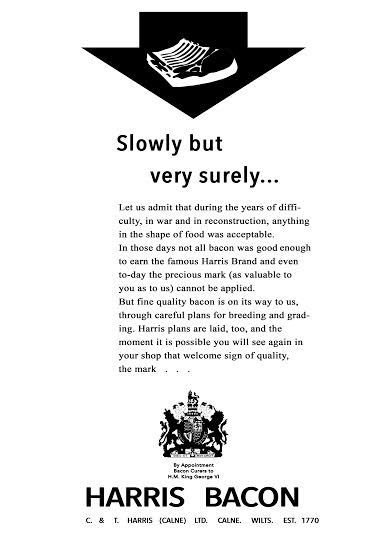
#gallery-0-22 { margin: auto; } #gallery-0-22 .gallery-item { float: left; margin-top: 10px; text-align: center; width: 100%; } #gallery-0-22 img { border: 2px solid #cfcfcf; } #gallery-0-22 .gallery-caption { margin-left: 0; } /* see gallery_shortcode() in wp-includes/media.php */
Harris Bacon photos, courtesy of Susan Boddington, curator of the Calne Heritage Centre.
#gallery-0-23 { margin: auto; } #gallery-0-23 .gallery-item { float: left; margin-top: 10px; text-align: center; width: 50%; } #gallery-0-23 img { border: 2px solid #cfcfcf; } #gallery-0-23 .gallery-caption { margin-left: 0; } /* see gallery_shortcode() in wp-includes/media.php */
Ancient photos from Germany
An old pic re-published in the doctoral dissertation of Klaus-Dieter Baja, University of Hamburg, on the changing face of the butches profession.
Vintage photos by Edward S Curtis
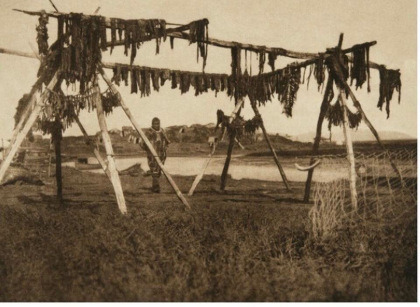
Drying Whale Meat – Hooper Bay (The North American Indian, V. XX. Norwood, MA, The PLIMPTON Press). Artist, Edward S Curtis.

Drying Meat, Flathead, 1910 – Hand colored vintage photogravure – 5 1/4 x 7 1/4 inches plate. Edward S. Curtis. From nygardgallery.com

An iconic photo by Curtis, Edward S., 1868-1952, created c1908 November 19, Two Dakota Indian women hanging meat to dry on poles, tent in background. Published in: The North American Indian / Edward S. Curtis. [Seattle, Wash.] : Edward S. Curtis, 1907-30, v. 3, p. 96.
Smokehouses

Meat Curing and Smokehouse – Built in Goria after plans by the United States Dep of Agriculture. Photo – 1919 from Woodford County Journal (Eureka, Illinois), 20 Jan 1919, p 3.
Photos from Robert Goodrick
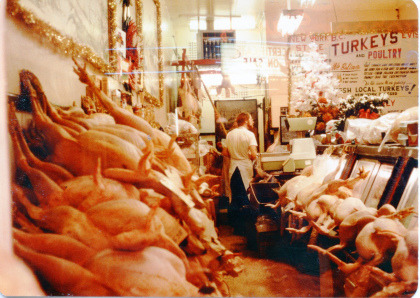
About this photo, he writes, “That was the year when we cleaned 900 pieces of poultry — I smelled like a turkey for weeks after :-(”
He says that “The bearded wonder in the center of the photo Quiet Waters Farm is yours truly 1974 I believe :)”
Robert remembers that “this is when ‘butchers’ was ‘real’ butchers 🙂 that Christmas we did over a 1000 birds which included a few ducks, geese, roasting chickens (6lb’ers) as well as a few (true) capons 9/10 lbs) — Largest turkey, if I remember right, was 55 lbs and the smallest was around 7/8 lbs — two of us cleaned the whole lot in about 12 hours”
“My third job in Vancouver British Columbia — My first lasted six weeks as I did not do the right handshake — another story for over a pint — Second lasted about six months as they were pulling the building down, so went down the street and joined this lot — ended up running the place for the owners :)”
How I love these stories!
Laurence Green’s references to Cape food.
From his work HARBOURS OF MEMORY (1969), published by Howard Timmins, Green makes the following references to meat and food recipes. Many of his best stories he got in bars, drinking with old folks and from magazines and old pamphlets he collected from flea markets. He was a journalist and an author and I think, if I recall correctly, at one point wrote for the Cape Argus or Cape Times. His word pictures are priceless. Here are a few nuggets.
The secret curry powder
From The Road to the Harbour he writes, “Hungry seamen paid sixpence for pea soup or fish, a shilling for roast beef or steak. Many generous hosts provided bread, cheese, and pickles free of charge. A favourite meal in many harbour taverns consisted of a plate of mulligatawny soup followed by sosaties and rice, curried fragments of mutton on bamboo skewers. This cost one shilling and sixpence, including a glass of wine.”
Curries of various sorts were favourite everyday meals in the seafaring quarter. If you passed down Waterkant or Bree Street between certain hours there were such pungent aromas of chilies and garlic, mustard oil and onions, that you might have been in Calcutta. Jacob Watermeyer, a Strand Street ship chandler, was the far-sighted businessman who transformed the curry and rice dishes of Cape Town. This remarkable episode brought him and his assistant a fortune. The master of a British sailing ship owed Watermeyer money for stores and he departed without paying the bill. Next time he called, however, the honest captain entered Watermeyer’s shop and announced: “I still can’t pay, but if you care to come down on board my ship I will show you something valuable.” Watermeyer and his assistant lunched in the saloon and were given the finest curry they had ever tasted. After lunch, the captain handed them a list of ingredients and showed them how to mix the curry powder which had made the lunch memorable. I do not pretend to know the exact amount of turmeric, ginger, chilies and other spices that went into the powder; it was a secret recipe. No one could say that it was dominated by this or that condiment. It was a true blend, and compared with the other curry powders of the period it seemed to have an almost magical effect on soups, pumpkin, beans, crawfish or snoek, eggs, chicken and meats. The captain revealed to Watermeyer the whole secret process and gave him a sealed barrel of the curry powder. Watermeyer canceled the debt, three hundred pounds, a substantial amount to write off in those golden days. He put the curry powder on the market in tins and Cape Town flocked to his store to buy more. Here was a powder with just the right bite. It gave a rich, almost mysterious stimulating quality to a thick stew. People glowed and perspired and declared that Watermeyer’s curry powder made them feel cool in the heat of summer. The assistant married Watermeyer’s daughter and inherited the secret. He built a store in Adderley Street far more ornate than the little ship chandler’s shop down on the waterfront. The store has gone but the curry powder survives and is still mixed just as that forgotten sea captain showed Jacob Watermeyer in the Indiaman’s saloon more than a century ago.
Few old people record their memories and I was lucky to hear the curry saga before the origin was lost. When an interesting person dies a whole page of the past is torn away. I am grateful to those who spoke to me and left their most vivid impressions
Picture from the Shambles – leopards and sand sharks
Leopards were still visiting the shambles at the foot of Adderley Street in search of offal when Hinton was a boy. Wharf Square, outside the old mainline railway station, was close to the wharf. The slaughterhouse, built long before the station, supplied meat to troops bound for India before the Suez Canal was built. Shortly after World War II an aged coloured man showed officials the door in this building where he had stood shovelling refuse into Table Bay. So many sand sharks gathered for the feast. that they called the place Haaibaai. Now the shambles has been demolished and the nearest sea is more than twelve hundred yards from Wharf Square.
Polony, existed from at least 1900’s with much older roots
“Butchers prepared fine mutton hams and polonies and these kept fresh in any climate. The polonies were a foot long, one inch in diameter, made of pork and other meats and fat with various spices; they were bound in bundles of twenty-four and sewn up in airtight bladders.”
See my article I did based on Greens description, The Origins of Polony.
Pigs in blankets were served as oysters, wrapped in bacon
About chef Luigi, he tells the following. “So he served “pigs in blankets” (oysters wrapped in bacon and fried) or oysters au gratin, sole and oyster pie, oysters sweated in butter and served on hot fried bread, oyster soufflees, oysters with spinach, grilled oysters and fried oysters chopped and mixed with scrambled eggs.”
From Australia
The country of Australia holds some of the most iconic meat history.
Tim Westwood made me aware of this remarkable video.
youtube
Meat Hangers
Kevin Ahern took these pictures of Petroglyphs National Monuments in Albuquerque, NM, dating to between 800 and 1200 BP with the oldest dating to 2000 BCE. He tells me that the images depict the Yucca bud.
“The uses of this plant are numerous, the least of which today being for textile use. The strikingly tall inflorescence stalks have long fibres in them that can be spun to make (incredibly uncomfortable) clothing, textiles, or rope. Yucca flowers are also edible, and are a deep-fried delicacy in some southern states in the US. Some species of the genus also have edible fruits, but this species isn’t one of them since the fruit walls are made up of very tough plant tissue. (botanicalmusings)
The leaves of this plant (Yucca filamentosa; Adams needle) are also sometimes referred to as “meat hangers” since they are so tough they can pierce meat and can be knotted together to make a ring that can be hung on a tree branch to dry-cured meat.” (botanicalmusings)
The reference to the hanging of meat for curing seems to originate from Small (1933) who recorded that “leaves of all southern species were used by pioneers to make rope and string for hanging up cured meats.” Daniel F. Austin says that he found fishermen in the early 1970s on Great Inagua near the Bahamas still using cord made from Yucca to hang their bonefish to dry. (Austin, 2004)
Yucca to the native tribe, Alabama was called tosiina istatakka (tosiina, from Spanish tocino for Bacon, ist-, it is, atakkaaka, hanging). The name is derived from their use of the sharp point on the leaf and its fibers to hang meat for smoking (Sylestine, et al, 1993) (Austin, 2004)
Further Reading and Reference:
http://botanicalmusings.blogspot.com/2012/08/the-northern-agave-yucca.html
Austin, F. D.. 2004. Florida Ethnobotany. CRC Press.
Old Meat Pictures from Мясо! Мясо! Колбаса
In July 2019 I was looking for old meat processing pictures for the deli stores concept we are launching in Johannesburg. Robert kindly directed me to this amazing facebook site. All photos were downloaded from this site where it was posted by members. I wish to acknowledge them and members of the site as the source.
Chuck Vavra‘s Grandparents
Making sausages
Todd Young’s photos
From South Africa

A photograph from L V Praagh, The Transvaal, and its Mines, 1906, p.321, of the curing room of a cold storage and butcher’s shop shows the importance of this imported European tradition in Johannesburg.

Sheepkraaling in the Karoo. Late 1800’s. From The Rise of Conservation in South Africa – Settlers, Livestock, and the Environment 1770-1950 by William Beinart.
Contributions
Please mail any contributions to [email protected] and help us preserve the rich heritage of our trade.
Pic’s history of meat processing Stockyard photos from Chicago Images from the Union Stock Yards, Chicago, USA, and pork abattoir's, from…
0 notes
Text
Review: Amun-Re
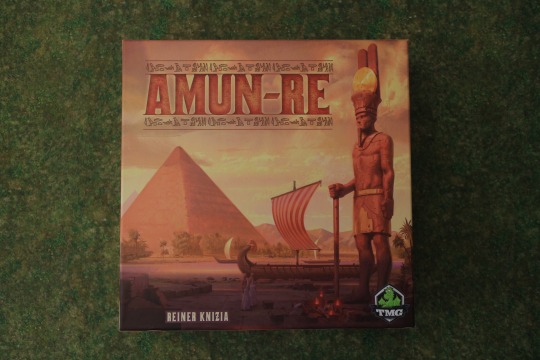
Sometimes when I sit and look through old family photo albums, I see people to whom I'm related, yet, I'm completely oblivious as to who they actually are. Even so, they aren't completely unfamiliar either. I think we all have that obscure aunt or cousin that came and visited us and while we have no immediate memory, we still had an uncomfortable picture taken and safely documented in the basement bin of photo albums.
And it is within those pictures we see something familiar. We see ourselves participating in Lord-knows-what, and wearing an outfit that I'm pretty sure my sister picked out because it probably looked intentionally ridiculous, smiling and have a great time. We're familiar with it because we see it, talk about it as it's right in front of us, and we are captivated by the fact that we were once in a place that we know and with people we know...except that weird uncle-in-law that apparently was super into Supertramp.
That's also how I feel about playing Knizia games.
They seem obscure...even weird and Supertrampy. But I'm somehow familiar with them because the execution of the mechanics is done so cleanly. It's like I'm hanging out with them in photographs taken in the late 70s.
Amun Re, originally published in 2003 though now recently updated in 2017 by Tasty Minstrel Games, is just one of those games. I've heard about this game for the better part of the last decade though have had apprehension about it (more later). Amun Re is a game of Area Control and Auctioning, and while I never laid eyes on the original version, I don't imagine that I ever care to at this point. Tasty Minstrel, as usual, curates and/or produces games of the highest quality, and Amun Re is no exception.

Usually games that are riddled with miniatures are judged on their quality (and, they should be). But it's usually those games that are only judged for quality. It's rare that someone speaks up about a euro game filled with cardboard chits and says "these components are gorgeous". It's cardboard. Amun Re in this case, is a game of euro-mechanics, but has these...gorgeous...miniature pyramids and bricks that (I'm assuming) are some sort of acrylic. They don't seem like typical soft plastic. In fact, I feel like I could easily throw one through the window (note: don't throw these through windows). The rest of the components are standard quality of cardboard and card stock (which isn't a slight against the quality), and the graphic design is laid out very well. One thing that I super-hate is trying to match symbols over and over again to their descriptions in the rulebook, as if I'm some sort of Egyptologist on an archeological excursion that probably should have paid better attention in school. Fortunately, it requires very little higher education, but if you get confused...hey, it's theme!
Amun Re features an auctioning / bidding mechanism that is pretty simple. Depending on the number of players, there will be provinces on the board that will have a card indicating the current or potential cost to bid for control. Once you place your bid, other players in turn order will place their bids, too. It's entirely possible that they could outbid you. WHY WOULD THEY DO THAT? Well, dear friends, they would do it for one of two reasons:
1. They're jerks.
2. The province has some sweet resources that they'd be fools to let pass by.
Oh, the bonus reason? Both of course. Only a jerk would take those sweet resources away from you, unless you're the one taking it away, in which case, it's a smart move.
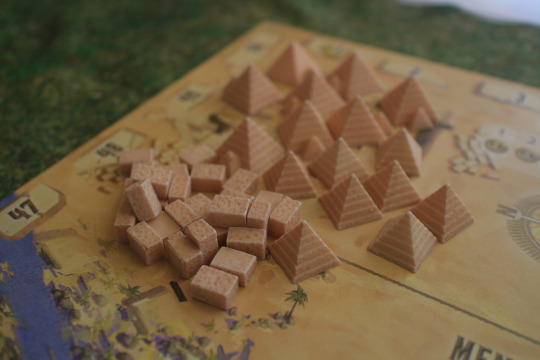
Resources aren't tight in this game (like in Railways of the World, where you start out as poor as a stone in a bucket of gravy*). But your available resources can't be spread far and wide, either. You want to dump your stuff in a really lucrative province that's going to have great return, so that you can keep adding to it and use these resources to dump into future lucrative provinces. You can collect bricks, which can be used for pyramids, which can be used for MORE pyramids. You can have farmers tiling the fertile Nile delta, bringing you profits unknown. You can let caravans camp in your provinces, for when there's a dry season, they'll bring you profits, too.
The dry or wet seasons are dependent upon how many sacrifices donations you can make to the god Amun Re. If you sacrifice donate enough people money, you can encourage the deity to send floods to your farms which will, as aforementioned, bring profits unknown. Or you can be one of those jerks again, and not send your people money to Amun Re and force a dry season to allow your caravans to seek profit instead of the farms.
All of this happens in a single age...the Old Age.
And then a thousand years pass.
[Not literally, because this would be the most boring game ever.]

Then the New Age comes. All that's left are the bricks and the pyramids that your ancestors left behind. The farms are gone. The caravans are gone. All of it. Gone. Whisked away with the sands of time (this is somewhat literal, considering it's in ancient Egypt and according to my recent Google Image search, there's a lot of sand there).
But that's the catch. All of the same provinces are going to be, more or less, re-auctioned to this new culture but along with the constructs that their ancestors left behind, significantly changing the value of all of them. What this means is that the bidding gets a bit grittier because you WANT those pyramids and you definitely want to take over that province with all the farms that one of the other jerks took out from underneath you. Jerks.
All this is happening with hand full of favor cards that can help you along the way by giving your farms bonuses, your caravans bonuses, extra cash during the delta floods, and even more bricks. Also, there are end-of-game bonuses that you can hang onto in your hand that will surely bring you even more fame. Got an end-game-bonus that clearly won't work? No worry...trade it in for gold, friend.
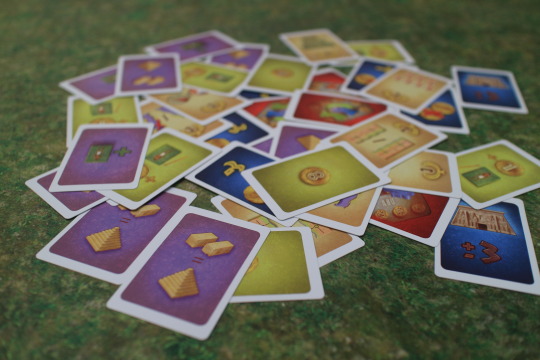
I've not played a lot of auction games. I'll admit that. And as such, I don't have much to compare it to, but the auction system in this game is seamless. It makes sense. It's perfect, actually. Of the auction games I have played, this is pretty solid and likely will be the standard at which I measure other auction games in the future. The card play, the bidding, the the sacrificing donating...it all makes sense and it all flows together. It's like I've been playing this game my whole life. It all works.
The only hang up I have (and this isn't the game's fault) is that it requires at minimum with 3 players. I do mostly 2p games, and 3p on occasion. It's rare that I get a 4p game in, though I did get a 4 player game of Amun Re in and it was fantastic. I'll say this: it scales really well from 3 to 5 players (disclosure, I've only played this with 3 players and 4 players). Cargo Noir by Days of Wonder kind pulls this off with 2p albeit a tad lackluster.
Look - I like this game. And though it's not my favorite Knizia game (that award goes to Ingenious), I love how well it goes together, and how familiar it all feels to me. While I'm looking forward to my next play, I'm not sure what category into which it fits. See, I can play a game like Ticket to Ride or Kingdom Builder over and over again, because while the game doesn't change, elements within change. I feel like this might feel like playing the same game with a dozen repeated plays (disclosure, I haven't a dozen plays of this game). I don't know. Veterans of this game may disagree; it's entirely possible that they would agree with me in this, and it within those familiarities and similarities between plays is the charm in and of itself.
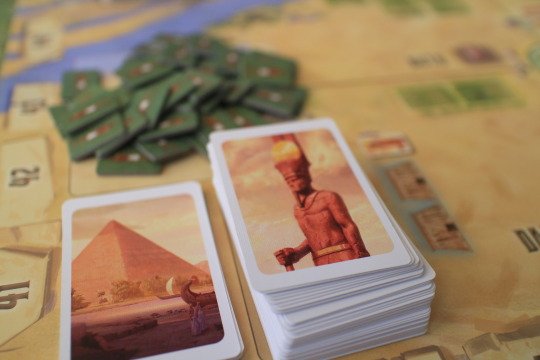
Ingenious is my absolute favorite Reiner Knizia game of all, and it is strictly abstract. A far contrast from the thematic elements in Amun-Re, it is still very similar among plays and that's what is charming about it. Amun Re may not be too far off of this either.
The rules, for whatever reason, leave some critical elements out, like, what do you do when the favor cards run out? A quick PDF search of the old version says to reshuffle the discards, so that's what we did.
All in all, this is a fine game, and is a great design. I don't know if it'll be a staple in my collection or not, but for those nights wherein I have 3 people wanting to play a game that will enjoy running some auctions and sacrifices donations, this may be the key ingredient
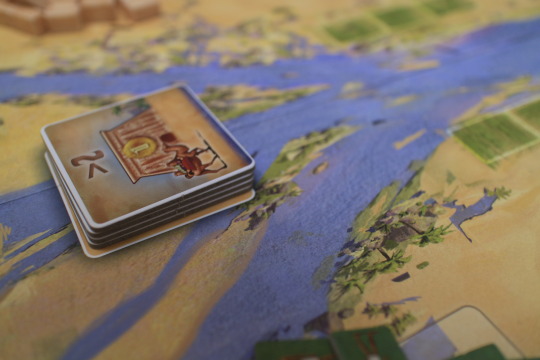
[note: Thanks to Tasty Minstrel for providing this review copy!]
* I just made up this simile. It doesn't make sense but it was what I could do with the lack of coffee I was experiencing at the time. Though, let's be honest: a guy with a bucket of gravy would indeed be a rich man.
3 notes
·
View notes
Link

By Shafik Meghji
1 April 2019
“Stay at least 200m away from the whaling station – it’s filled with asbestos and the roofs could literally blow off,” warned expedition leader Nate Small, as we stepped gingerly out of our Zodiac and into the fizzing surf at Stromness Bay, South Georgia. I picked a careful route across the grey-pebble beach, eyeing warily the growling fur seals and slumbering elephant seals, their gargantuan bodies emitting a series of burps, bellows and rumbling bass notes.
At the far end of the bay, set against a mountain slope and surrounded by bog land, was a cluster of dilapidated, rusty, corrugated iron buildings. Huge sections of the roofs and walls were missing, and those that remained rattled incessantly in the near gale-force wind. It looked as if a natural disaster had struck. I stopped at an ‘Asbestos – Keep Out’ sign and peered through the encroaching mist, my extremities numb from the sub-zero conditions. It was a struggle to picture the station as a thriving community, yet a century ago Stromness was part of a highly profitable – and brutal – industry that transformed South Georgia into the whaling capital of the South Atlantic.
View image of Stromness, South Georgia, was once part of a highly profitable – and brutal – industry (Credit: Credit: Zoonar GmbH/Alamy)
You may also be interested in:
• The city that lit the world
• A strange life at the end of the world
• Is this the world’s last paradise?
Earlier in my trip, Seb Coulthard, expedition guide and on-board historian for Polar Latitudes, told me how Ernest Shackleton arrived in Stromness in 1916 following his epic 1,300km escape from Elephant Island, one of the South Shetland Islands that lie just north of the Antarctic Peninsula, after his ship was trapped and later crushed by pack ice. For the polar explorer, the whaling station represented civilisation, but today nature is slowly reclaiming it. Fur seals sheltered beside a blubber cooker, king penguins waddled past disintegrating warehouses and skuas (aggressive, dark-brown seabirds) washed themselves in meandering streams that once ran with the blood of tens of thousands of whales.
A rugged, inhospitable land of glaciers, mountains and fjords, South Georgia is one of the most remote places on Earth. This sub-Antarctic British overseas territory in the South Atlantic is around 1,400km from its nearest inhabited neighbour, the Falkland Islands, and is only accessible by sea. Like me, the majority of the nearly 18,000 people who visit each year are on Antarctic cruises. The island spans 3,755 sq km – less than a fifth of the size of Wales – and around half is covered permanently by ice (though, as a result of climate change, its glaciers are drastically retreating).
Despite its isolation and harsh environment, South Georgia was once a vital part of the global economy. First sighted in 1675, this uninhabited island was claimed for Great Britain by James Cook in 1775. His accounts of abundant seal populations aroused the interest of sealers from the UK and the US. In little more than a century, South Georgia’s fur seals were hunted to the verge of extinction. By the early 1900s, sealing was no longer economically viable, but it was quickly replaced by an equally bloody industry.
View image of South Georgia was once a vital part of the global economy, but today it’s being reclaimed by nature (Credit: Credit: Shafik Meghji)
The day after my visit to Stromness, my ship sailed south through 75-knot winds to King Edward Cove. Scattered with shipwrecks and mini icebergs, backed by forbidding mountains and obscured by drizzle, this sweeping bay was the location of South Georgia’s first whaling station, Grytviken. Today it is the site of the island’s main settlement, home to the majority of the 15 to 30 people, mostly scientists and government officials, who live on South Georgia at any one time.
After paying my respects to Shackleton, who is buried in Grytviken’s small cemetery, I was taken around the decaying whaling station by Finlay Raffle, a curator at the site’s museum. We walked through an industrial landscape of squat towers, warehouses, power plants, mazes of inter-connected pipes, and huge blubber and bone cookers, everything thickly covered with rust. Along the shoreline, ships and boats in varying stages of collapse were pushed up at odd angles by the tide. Chunks of whale bone carpeted the muddy ground.
In 1902, Norwegian polar explorer Carl Anton Larsen stopped in South Georgia and chanced upon a beautiful natural harbour. After the discovery of several sealers’ try-pots – used to render oil from blubber – the area was named Grytviken (‘Pot Cove’ in Norwegian). “They moored not far off from where your ship is today,” Raffle said. “The only difference was when they looked out over the water they saw hundreds of whales in this bay alone.” With the northern hemisphere whaling industry in decline due to the decimation of whale populations, Larsen spotted a business opportunity. He returned to Grytviken in November 1904 and set up a whaling station, which swiftly prospered. By 1912, there were six other whaling stations on South Georgia, including Stromness.
View image of Grytviken, South Georgia’s first whaling station, is the site of the island’s main settlement (Credit: Credit: Shafik Meghji)
Narrowly dodging a pair of fur seals, who blended in remarkably well with the rusty machinery, we approached an old whale-catcher. With its steam-powered engine, reinforced hull and mighty harpoon gun, the whaling ship Petrel could capture as many as 14 whales on a single trip. Back at Grytviken, the animals would be winched onto a slipway, the ‘flensing plan’. “It was very slippery with all the blood and oil, so the men wore boots with nails in them to grip properly” Raffle said. “They had a flensing knife – a long, almost hockey stick with a sharp, curved blade, which they used to cut the blubber away.” The whole process took 20 minutes per whale.
Initially the whalers were only interested in the blubber, but later regulations forced them to use the whole of the carcass, Raffle explained, pointing out gory rotating blades and a 24-tonne blubber cooker. Although the meat and bone-meal were sold as animal feed and fertiliser, whale oil was the real prize. “The best oils went into food products like margarine and ice cream,” he said. “The second grade went into soap and cosmetics, and the worst was used in industrial processes.” Whale oil also provided glycerol, used in the manufacture of explosives, and high-quality lubricants for rifles, chronometers and other military equipment. As a result, demand soared during World War One and Two.
There were 450 men at Grytviken in its heyday, working 12-hour shifts, seven days a week, in temperatures that could plunge below -10C. Larsen was keen to look after their spiritual needs, building an impressive neo-Gothic church. But, said Raffle said, the pastor “was the least employed man on the station”. The cinema, windswept football pitch and ski jump – now just a few bits of broken timber protruding from a hillside – proved rather more popular. The community store, or ‘slop chest’, also provided distractions. “Tobacco was the most popular item but the men also bought lots of cologne,” Raffle said. “Larsen didn’t allow alcohol, so they drank cologne instead. They also had illicit stills, and even got boot polish, squeezed it through bread, and drank the drippings, which apparently also had alcohol. Anything to pass the time.”
View image of The whaling ship Petrel could capture as many as 14 whales on a single trip (Credit: Credit: David Tipling Photo Library/Alamy)
Raffle left me at the former manager’s house, a simple, white-washed building that has been turned into the site’s museum. The displays inside contain some stark figures: 175,250 whales were processed on South Georgia between 1904 and 1965, when the industry collapsed due to over-hunting and developments in the petrochemicals industry. If you consider the Antarctic region as a whole and include the many ‘factory ships’ that processed whales on board, almost 1.5 million whales were killed between 1904 and 1978, when hunting of the species eventually ended.
Whale populations haven’t recovered. The International Whaling Commission (IWC) says blue whale numbers in the southern hemisphere have fallen from as many as 200,000 to the ‘low thousands’; fin whales have undergone a similar decline. There are an estimated 60,000 humpbacks in the southern hemisphere, but this is also far lower than the pre-whaling era. In September 2018, IWC plans for a South Atlantic whaling sanctuary were rejected by pro-whaling countries. Japan later announced it will resume commercial whaling for the first time in three decades, prompting global outrage.
It’s a bittersweet irony in that it was a terrible, brutal industry, yet nature took its sweet revenge by reclaiming it
The plight of the whales is undeniably bleak, but in other respects, South Georgia has become an improbable model of conservation. One of the world’s largest marine reserves, the South Georgia and South Sandwich Islands Marine Protected Area, was created here in 2012 to protect more than one million sq km of the surrounding waters, while seal numbers have bounced back: the island now has 98% of the world’s Antarctic fur seals and roughly 50% of its elephant seals.
South Georgia also has 30 million breeding pairs of seabirds. During my visit, I spent a morning at St Andrews Bay in the company of 400,000 king penguins – one of four penguin species found on the island – and an afternoon on Prion Island, an important breeding site for wandering albatrosses. Last year, South Georgia was declared rodent-free after a pioneering eradication programme, which the authorities hope will allow birds like the endemic South Georgia pipit and South Georgia pintail to flourish.
View image of South Georgia is now home to large populations of fur and elephant seals and around 400,000 king penguins (Credit: Credit: Shafik Meghji)
Despite the profusion of wildlife, it was the island’s whaling heritage that remained foremost in my mind as I sailed out of Grytviken. “When you walk about these stations all you see are these rusting boilers, blubber cookers and bone saws,” Coulthard said. “It’s a bittersweet irony in that it was a terrible, brutal industry, yet nature took its sweet revenge by reclaiming it. It’s a reminder that nature doesn’t need human beings; we need nature.”
This trip was made possible by Polar Latitudes. Trips to South Georgia are also available through Quark Expeditions, One Ocean Expeditions and National Geographic Expeditions, among other operators.
Join more than three million BBC Travel fans by liking us on Facebook, or follow us on Twitter and Instagram.
If you liked this story, sign up for the weekly bbc.com features newsletter called "If You Only Read 6 Things This Week". A handpicked selection of stories from BBC Future, Culture, Capital and Travel, delivered to your inbox every Friday.
BBC Travel – Adventure Experience
0 notes
Text
Aether for Redditors
Hey there!
Due to the recent news about Reddit, we've had a few redditors coming to check us out. Which is awesome, so I wanted to write a guide about how Aether compares to Reddit, and what it does similarly, and differently. Likely you'll be fairly comfortable quick, but there are still a few interesting aspects of Aether you might want to keep in mind as you warm up.
We are a small, friendly community, consider this a welcome pack. 🙂
As I hear more and more questions from redditors in the community, this might be updated occasionally.
Aether is a peer-to-peer network
This is the most major, obvious difference. Aether has no servers. It exists ... nowhere, really. As a result, Aether is an app, not a website. It's available for Windows, Mac and Linux, and mobile apps are (eventually) coming.
This has a few implications. When you post on Aether, what happens is that your computer starts to share the content you posted. Other computers will get that content from you, and they will broadcast it to other computers, letting your post spread to the network in a sweeping fashion. As of February 2019, a post takes about ten minutes to reach the whole network.
That means Aether app is an app that needs to keep running in the background, like an email client.
If you post something, and then close the app immediately, that content will not be delivered to other people.
If you want to be sure your post is delivered, wait half an hour or so. Aether just stays on the taskbar / menubar (like Discord), so you can close the window and it'll continue to work in the background. In the future this is going to be visible in the UI when your post has spread to the network. (Like double checkmark from messaging apps)
Aether is ephemeral (like Snapchat - things disappear eventually)
Anything you post on Aether will be gone in about 6 months. This is nice, because no one can stalk your decade's worth of Reddit history and figure out where you sleep.
This is both a philosophical and a practical thing.
It is a philosophical thing, because having information gone vastly improves privacy. It also makes people be able to discuss more freely, without being concerned about whatever they wrote will bite them ten years into the future. We all grow up, and we were all less experienced when we were younger. Aether tries to respect the humanity in that by deleting too-old content.
But it is also a practical thing since it's a peer to peer network, it is limited by the disk space of its participants, so we try to be respectful of that as well.
Unlike Reddit, in Aether, moderator actions are visible to users
First of all, before anything, no one can edit your posts except you. It is cryptographically impossible. You'd think no one would do that, but given the current climate, you'd (sadly) be wrong.
Beyond that, when a moderator takes an action (delete a comment, let's say), that action is visible on the community's mod actions feed. This is a feed of events that mods generate that shows exactly what got deleted, and the reason why.
You can disable any mod, and choose anyone as a mod
In Aether, if you don't like what a mod is doing, you can just disable him. Flip a switch, and everything he deleted reappears. You can also choose a non-mod as a mod.
There is a 'front page' list of communities, called SFW list
These SFWlisted communities are the ones that appear on the front page. This is a limited, curated list of larger communities. You can always create your own community without ever needing to get into this front-page-eligible list of communities if you want. You can also disable this list completely by following the instructions in the app if you want.
Like Reddit, Aether is within the jurisdiction of the United States
That means US law applies — it is not a free-for-all. We have to remove copyrighted content via DMCA, as well as illegal (and those with reasonable chance of being illegal) content.
Aether keeps a copy of the whole network on your machine
This is why it can be so snappy: you can post offline, and when you connect, those posts will be spread to the network. The 'whole of the network' is actually very small, because Aether only carries compressed text. It doesn't carry images, videos, or anything else, so you need to post to Imgur or other image hosts, similar to Reddit.
This also emphasises the importance of no-illegal-content mentioned above. Since we all carry the text of the whole of the network, it's in all our best interest to keep the network clean. It's very hard to make text illegal, however, it's up to all of us to keep it as such. If you see something illegal, use the report button, or send an email with a link to it.
(And yes, there are guards to prevent spammers from creating a million posts and bloating the network size, such as required proofs-of-work.)
Aether is a work-in-progress
Despite the UI, Aether is still very much a work in progress. There are parts of the app that are being worked on, such as elections, being able to add a second mod to a community (Aether communities are denoted as b/Community instead of r/Subreddit) and so on. Things will break, and perhaps repeatedly so. At this point (a month after its release in December) things generally work provided that you have a stable internet connection and can keep the app open appropriately. Nevertheless, this is alpha software. If you have any bugs or feature requests, file them at https://meta.getaether.net. b/Meta is also a good place. (The link requires you have Aether installed)
Like Reddit, you can link to Aether from the web
Here's an example link:
aether://board/86e782e80681ac580b4d6d102b12e787c066e59f194fee57bb0bf83cc1e42fc6
(this links to b/Meta)
Notice aether:// instead of http:// at the beginning. As mentioned above, it needs the recipient to have Aether installed, though. We'll eventually have a preview site on the regular web that can show content without needing it installed, but again, work in progress. 🙂
If you want to post on Reddit or Twitter, and have it be recognised as a link, you can shorten the links at TinyURL, which accepts and shortens Aether links. Or if the place supports Markdown, like Reddit, you can always do:
[my link name](aether://board/86e782...e42fc6)
And make it show up as a link that way.
Aether is paid for by the 'unique' (orange) usernames and its business version
Since the current conversation is around how Reddit is funded, I want to be completely transparent about how Aether makes money (it makes very, very little money) as well. Here's how this works.
a) Similar to Reddit's gold, if you want to support Aether, you can buy a 'unique' username (with a checkmark, like Twitter) that makes you the unique owner of that username for the donation duration. If you want to do so, check out the Patreon.
b) Aether also has an upcoming business version, that allows a company to purchase a private instance of Aether for their own internal use. This comes with a few nice additions, like being able to use email to create threads and posts, and get emails back when other people post. It's good as a productivity, tool, and it's much better than Slack because it interrupts your people less. If you're a tech lead and interested in piloting this with your team, please reach out via email and we'll set you up.
Sounds interesting? Try Aether here. Hope to see you around!
0 notes
Photo


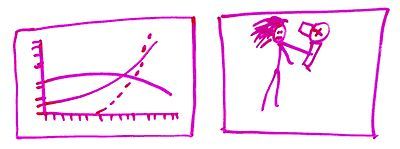
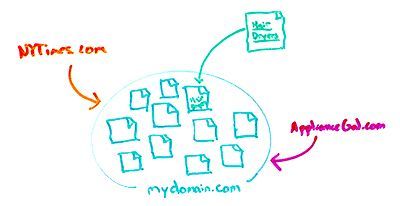
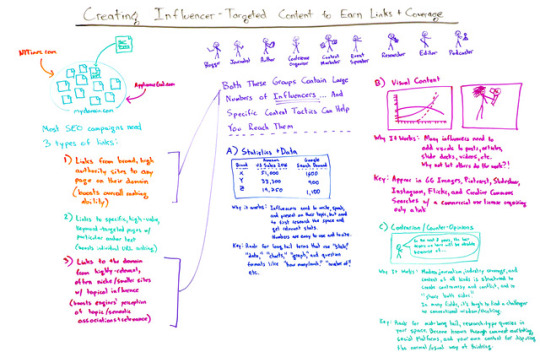
Creating Influencer-Targeted Content to Earn Links + Coverage - Whiteboard Friday
Posted by randfish Most SEO campaigns need three kinds of links to be successful; targeting your content to influencers can get you 2/3 of the way there. In this Whiteboard Friday, Rand covers the tactics that will help your content get seen and shared by those with a wide and relevant audience.
Click on the whiteboard image above to open a high-resolution version in a new tab! Video Transcription Howdy, Moz fans, and welcome to another edition of Whiteboard Friday. This week we’re going to chat about how to create content that is specifically influencer-targeted in order to earn the links and attention and amplification that you often need.
Most SEO campaigns need 3 types of links:
So it’s the case that most SEO campaigns, as they’re trying to earn the rankings that they’re seeking, are trying to do a few things. You’re trying to grow your overall Domain Authority . You’re trying to get some specific keyword terms and phrases ranking on your site for those terms and phrases.
So you need kind of three kinds of links. This is most campaigns.
1. Links from broad, high-Domain Authority sites that are pointing — you kind of don’t care — anywhere on your site, the home page, internal pages, to your blog, to your news section . It’s totally fine. So a common one that we use here would be like the New York Times. I want the New York Times to link to me so that I have the authority and influence of a link from that domain and, hopefully, lots of domains like them, very high-Domain Authority domains.
2. Links to specific high-value keyword-targeted pages, hopefully, hopefully with specific anchor text , and that’s going to help me boost those individual URLs’ rankings. So I want this page over here to link to me and say “hairdryers,” to my page that is keyword targeted for the word “hairdryers.” Fingers crossed.
3. Links to my domain from other sites, in my sector or niche, that provide some of that topical authority and influence to help tell Google and the other search engines that this is what my site is about, that I belong in this sphere of influence, that I’m semantically and topically related to words and phrases like this. So I want appliancegal.com to link to my site if I’m trying to rank in the world of hairdryers and other kinds of appliances.
So of these, for one and three, we won’t talk about two today, but for one and three, much of the time the people that you’re trying to target are what we call in the industry influencers, and these influencers are going to be lots of people. I’ve illustrated them all here — mostly looking sideways at each other, not exactly sure why that is — but bloggers, and journalists, and authors, and conference organizers, and content marketers, and event speakers, and researchers, and editors, and podcasters, and influencers of a wide, wide variety. We could fill up the whole board with the types of people who are in the influencer world or have that title specifically, but they tend to share a few things in common. They are trying to produce content of one kind or another. They’re not dissimilar from us. They’re trying to produce things on the web, and when they do, they need certain elements to help fill in the gap. When they’re looking for those gap-filling elements, that is your opportunity to earn these kinds of links.
Content tactics So a few tactics for that. First off, one of the most powerful ones, and we’ve talked about this a little bit here on Whiteboard Friday, but probably not in depth, is...
A. Statistics and data. The reason that this is such a powerful tool is because when you create data, especially if it’s either uniquely gathered by you, unique because you have it, because you can collect it and no one else can, or unique because you’ve put it together from many disparate sources, you’re the editorial curator of that data and statistics, everyone like this needs those types of statistics and data to support or challenge their arguments or their assertions or their coverage of the industry, whatever it is.
Why this works: This works well because this fills that gap. This gives them the relevant stats that they’re looking for. Because numbers are easy to use and easy to cite, and you can say, “Feel free to link to this. You’re welcome to copy this graph. You’re welcome to embed this chart.” All those kinds of things. That can make it even easier, but much of the time, just by having these statistics, you can do it.
The key is that you have to be visible at the time that these people are looking for them, and that means usually ranking for very hard to discover, through at least normal keyword research, long-tail types of terms that use words like “stats,” “data,” “charts,” “graphs,” and kind of these question formats like when, how much, how many, number of, etc.
It’s tough because you will not see many of those in your keyword research, because there’s a relatively few number of these people searching in any given month for this type of gap-filling data, so you have to intuit often what you should title those things. Put yourself in these people’s shoes and start Googling around for “What would I need if I had to write some industry coverage around this?” Then you’ll come up with these types of things, and you can try modifying your keyword research queries or doing some Google Suggest stuff with these words and phrases.
B. Visual content. Visual content is exceptionally valuable in this case because, again, it fills a gap that many of these folks have. When you are a content marketer, or when you’re a speaker at an event, or when you’re an author or a blogger, you need visual content that will help catch the eye, that will break up the writing that you’ve done, and it’s often much easier to get someone else’s visual content and simply cite your source and link to it than it is to create visual content of your own. These people often don’t have the resources to create their own visual content.
Why this works: So, for everyone who’s doing posts, and articles, and slide decks, and even videos, they say, “Why not let someone else do the work,” and you can be that someone else and fill these gaps.
Key: To do this well, you’re going to want to appear in a bunch of visual content search mediums that these folks are going to use. Those are places like...
Google Images most obviously, but also
Pinterest
SlideShare , meaning take your visuals, put them up in some sort of slide format, give some context to them and upload them to SlideShare. The nice thing about SlideShare, SlideShare actually reproduces each individual slide as a visual, and then Google Images can search those, and so you’ll often see SlideShare’s results inside Google Images. So this can be a great end around for that.
Instagram search , many folks are using that especially if you’re doing photos. You can see I’ve illustrated my own hair drying technique right here. This is clearly Rand. Look at me. I’ve got more hair than I know what to do with.
Flickr , still being used by many searchers, particularly because it has a Creative Commons search license, and that should bring up using a Creative Commons commercial use license that requires attribution with a link is your best bet for all of these platforms. It will mean you can get on lots of other Creative Commons visual and photography search engines, which can expose you to more of these types of people as they’re doing their searches.
C. Contrarian/counter-opinions. The last one I’ll cover here is contrarian or counter-opinions to the prevailing wisdom. So you might have an opinion like, “In the next three years, hairdryers will be completely obsolete because of X.”
Why it works: This works well because modern journalism has this idea and modern content, in fact, has this idea that they are supposed to create conflict and that they should cover both sides of an issue. In many industry specific sorts of fields, it’s often the case that that is a gap that goes unfilled. By being that sort of challenger to conventional wisdom or conventional thinking, you can fill that gap.
The key here is you want to either rank in Google search engine for some of those mid or long tail research type queries. These can be competitive, and so this is challenging, but presenting contrarian opinions is often great link bait. This is kind of a good way to earn links of all kinds in here.
Second, I would also urge you to do a little bit of comment marketing and some social media platforms , because what you want to start is to build a brand where you are known for having this contrarian opinion on this conventional topic in your space so that people point all these influencers to you when they’re asked about it. You’re trying to build up this branding of, “Well, I don’t agree with the conventional wisdom around hairdryers.” Hairdryers might be a tough topic for that one, but certainly these other two can work real well.
So using these tactics, I hope that you can go reach out and fill some gaps for these influencers and, as a result, earning two of the three exact kind of links that you need in order to rank well in the search results.
And we’ll see you again next week for another edition of Whiteboard Friday. Take care.
Video transcription by Speechpad.com
Sign up for The Moz Top 10 , a semimonthly mailer updating you on the top ten hottest pieces of SEO news, tips, and rad links uncovered by the Moz team. Think of it as your exclusive digest of stuff you don’t have time to hunt down but want to read!
http://bit.ly/2sHXhPB
#leadgeneration #contentwriting #digitalmarketing #lagunabeachseo #smallbusinessmarketing #seo #articlewriting #huntingtonbeachseo #bestlocalseo #socialmediamarketing
#leadgeneration#contentwriting#digitalmarketing#lagunabeachseo#smallbusinessmarketing#seo#articlewriting#huntingtonbeachseo#bestlocalseo#socialmediamarketing
1 note
·
View note